External Quality Assurance
VerifiedAdded on 2023/06/05
|19
|7486
|324
AI Summary
This article discusses the functions, key concepts and principles of external quality assurance of assessment. It evaluates the roles of practitioners involved in the quality assurance process and explains the regulations and requirements for external and internal quality assurance. It also emphasizes the importance of planning and preparing external quality assurance activities and provides insights on how to adapt external monitoring and evaluation approaches to meet customer needs without compromising quality standards.
Contribute Materials
Your contribution can guide someone’s learning journey. Share your
documents today.
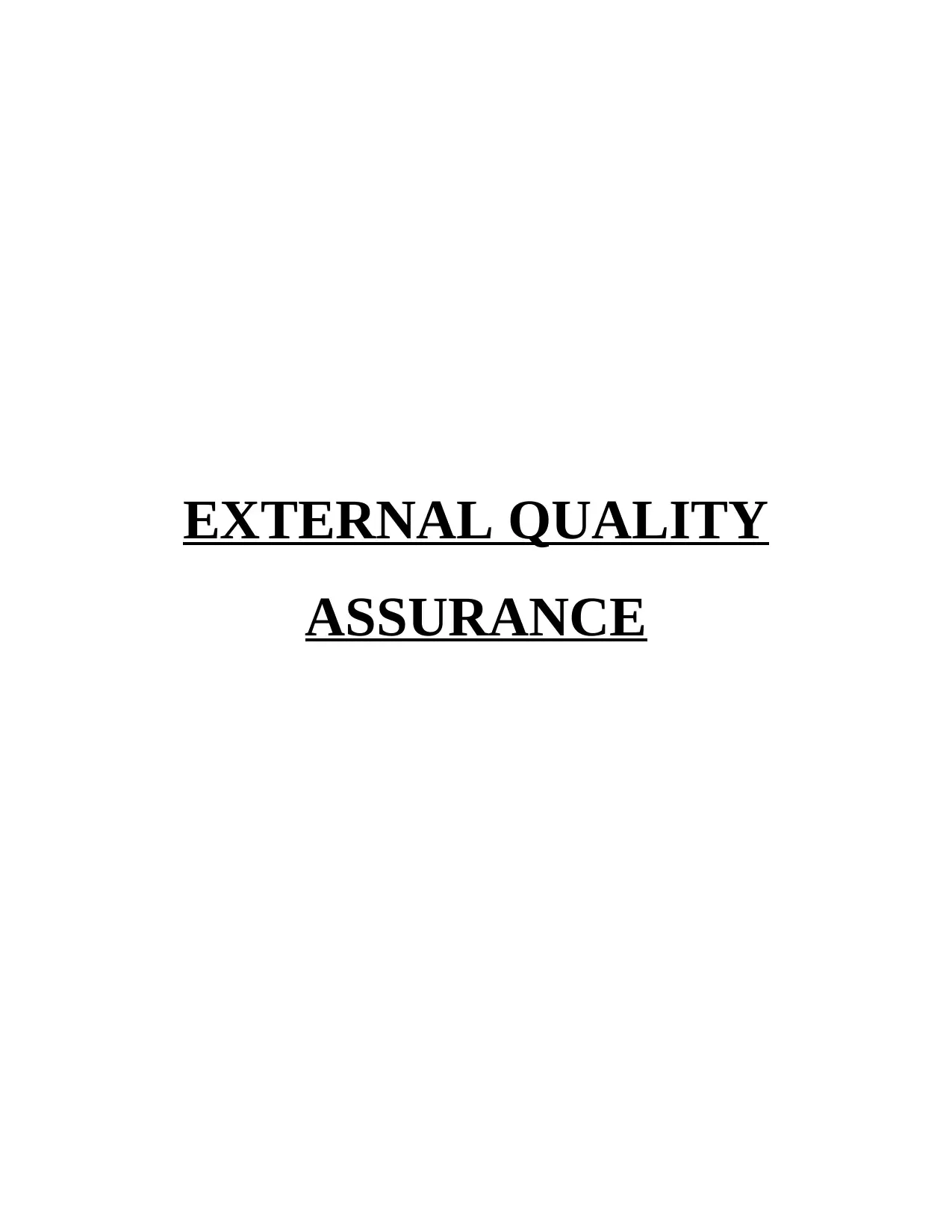
EXTERNAL QUALITY
ASSURANCE
ASSURANCE
Secure Best Marks with AI Grader
Need help grading? Try our AI Grader for instant feedback on your assignments.
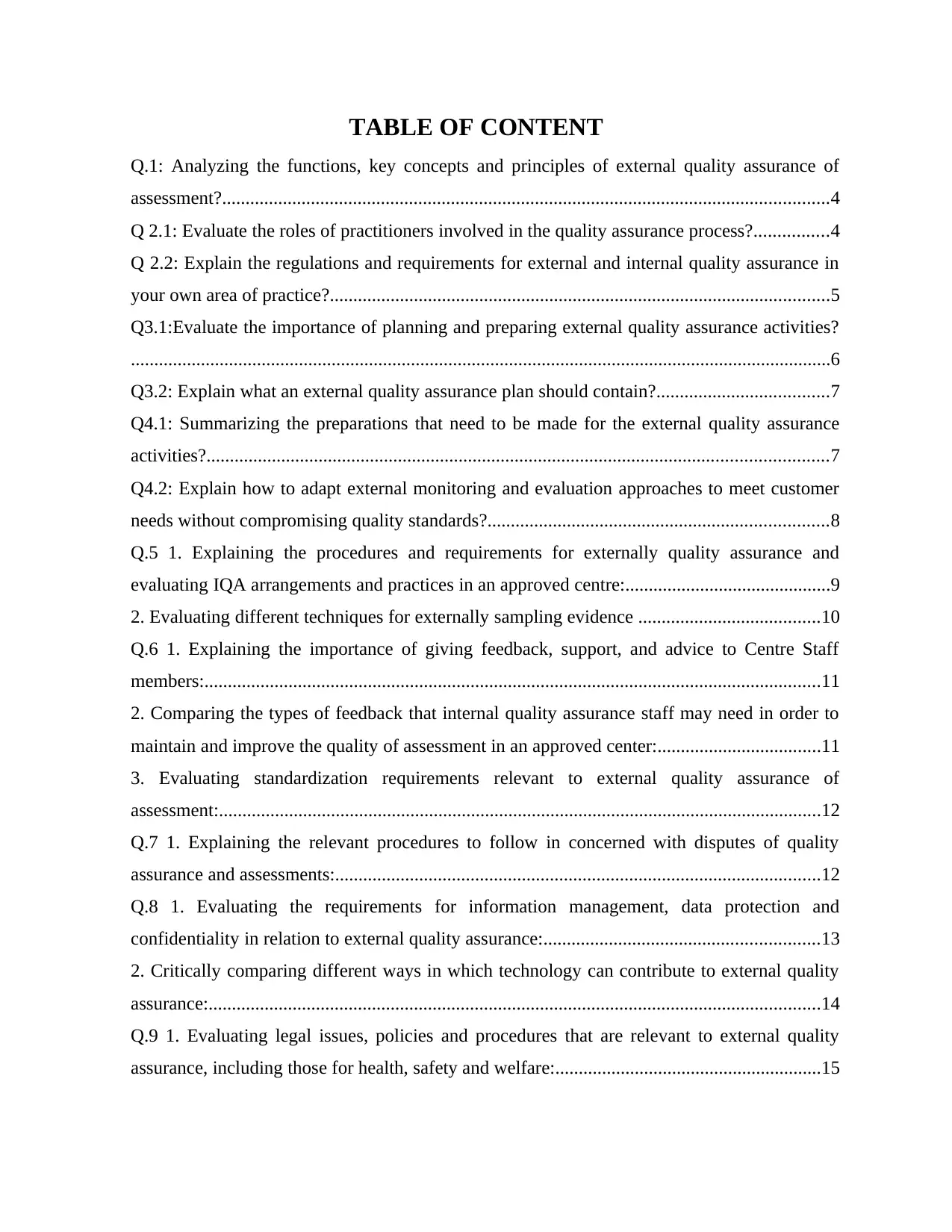
TABLE OF CONTENT
Q.1: Analyzing the functions, key concepts and principles of external quality assurance of
assessment?..................................................................................................................................4
Q 2.1: Evaluate the roles of practitioners involved in the quality assurance process?................4
Q 2.2: Explain the regulations and requirements for external and internal quality assurance in
your own area of practice?...........................................................................................................5
Q3.1:Evaluate the importance of planning and preparing external quality assurance activities?
......................................................................................................................................................6
Q3.2: Explain what an external quality assurance plan should contain?.....................................7
Q4.1: Summarizing the preparations that need to be made for the external quality assurance
activities?.....................................................................................................................................7
Q4.2: Explain how to adapt external monitoring and evaluation approaches to meet customer
needs without compromising quality standards?.........................................................................8
Q.5 1. Explaining the procedures and requirements for externally quality assurance and
evaluating IQA arrangements and practices in an approved centre:............................................9
2. Evaluating different techniques for externally sampling evidence .......................................10
Q.6 1. Explaining the importance of giving feedback, support, and advice to Centre Staff
members:....................................................................................................................................11
2. Comparing the types of feedback that internal quality assurance staff may need in order to
maintain and improve the quality of assessment in an approved center:...................................11
3. Evaluating standardization requirements relevant to external quality assurance of
assessment:.................................................................................................................................12
Q.7 1. Explaining the relevant procedures to follow in concerned with disputes of quality
assurance and assessments:........................................................................................................12
Q.8 1. Evaluating the requirements for information management, data protection and
confidentiality in relation to external quality assurance:...........................................................13
2. Critically comparing different ways in which technology can contribute to external quality
assurance:...................................................................................................................................14
Q.9 1. Evaluating legal issues, policies and procedures that are relevant to external quality
assurance, including those for health, safety and welfare:.........................................................15
Q.1: Analyzing the functions, key concepts and principles of external quality assurance of
assessment?..................................................................................................................................4
Q 2.1: Evaluate the roles of practitioners involved in the quality assurance process?................4
Q 2.2: Explain the regulations and requirements for external and internal quality assurance in
your own area of practice?...........................................................................................................5
Q3.1:Evaluate the importance of planning and preparing external quality assurance activities?
......................................................................................................................................................6
Q3.2: Explain what an external quality assurance plan should contain?.....................................7
Q4.1: Summarizing the preparations that need to be made for the external quality assurance
activities?.....................................................................................................................................7
Q4.2: Explain how to adapt external monitoring and evaluation approaches to meet customer
needs without compromising quality standards?.........................................................................8
Q.5 1. Explaining the procedures and requirements for externally quality assurance and
evaluating IQA arrangements and practices in an approved centre:............................................9
2. Evaluating different techniques for externally sampling evidence .......................................10
Q.6 1. Explaining the importance of giving feedback, support, and advice to Centre Staff
members:....................................................................................................................................11
2. Comparing the types of feedback that internal quality assurance staff may need in order to
maintain and improve the quality of assessment in an approved center:...................................11
3. Evaluating standardization requirements relevant to external quality assurance of
assessment:.................................................................................................................................12
Q.7 1. Explaining the relevant procedures to follow in concerned with disputes of quality
assurance and assessments:........................................................................................................12
Q.8 1. Evaluating the requirements for information management, data protection and
confidentiality in relation to external quality assurance:...........................................................13
2. Critically comparing different ways in which technology can contribute to external quality
assurance:...................................................................................................................................14
Q.9 1. Evaluating legal issues, policies and procedures that are relevant to external quality
assurance, including those for health, safety and welfare:.........................................................15
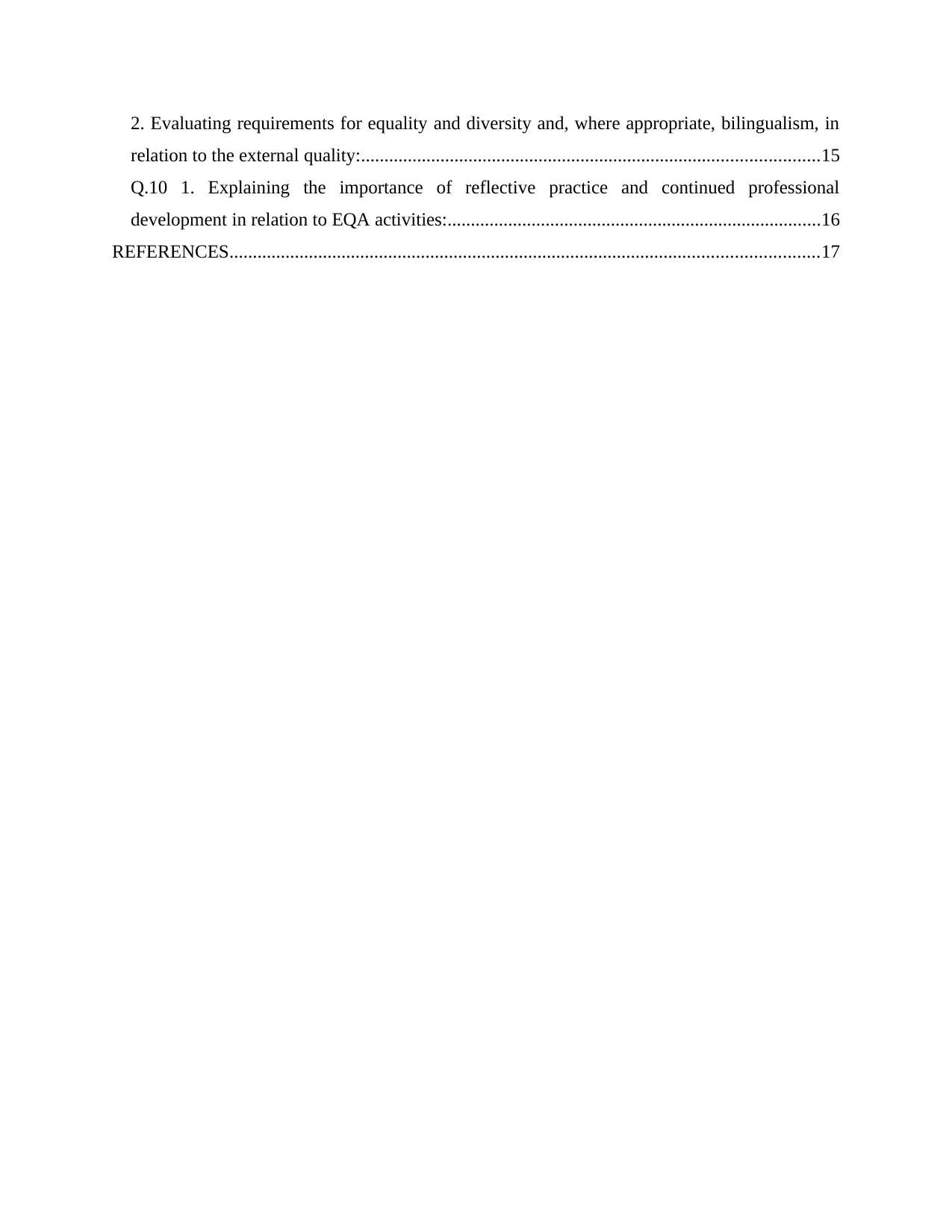
2. Evaluating requirements for equality and diversity and, where appropriate, bilingualism, in
relation to the external quality:..................................................................................................15
Q.10 1. Explaining the importance of reflective practice and continued professional
development in relation to EQA activities:................................................................................16
REFERENCES..............................................................................................................................17
relation to the external quality:..................................................................................................15
Q.10 1. Explaining the importance of reflective practice and continued professional
development in relation to EQA activities:................................................................................16
REFERENCES..............................................................................................................................17
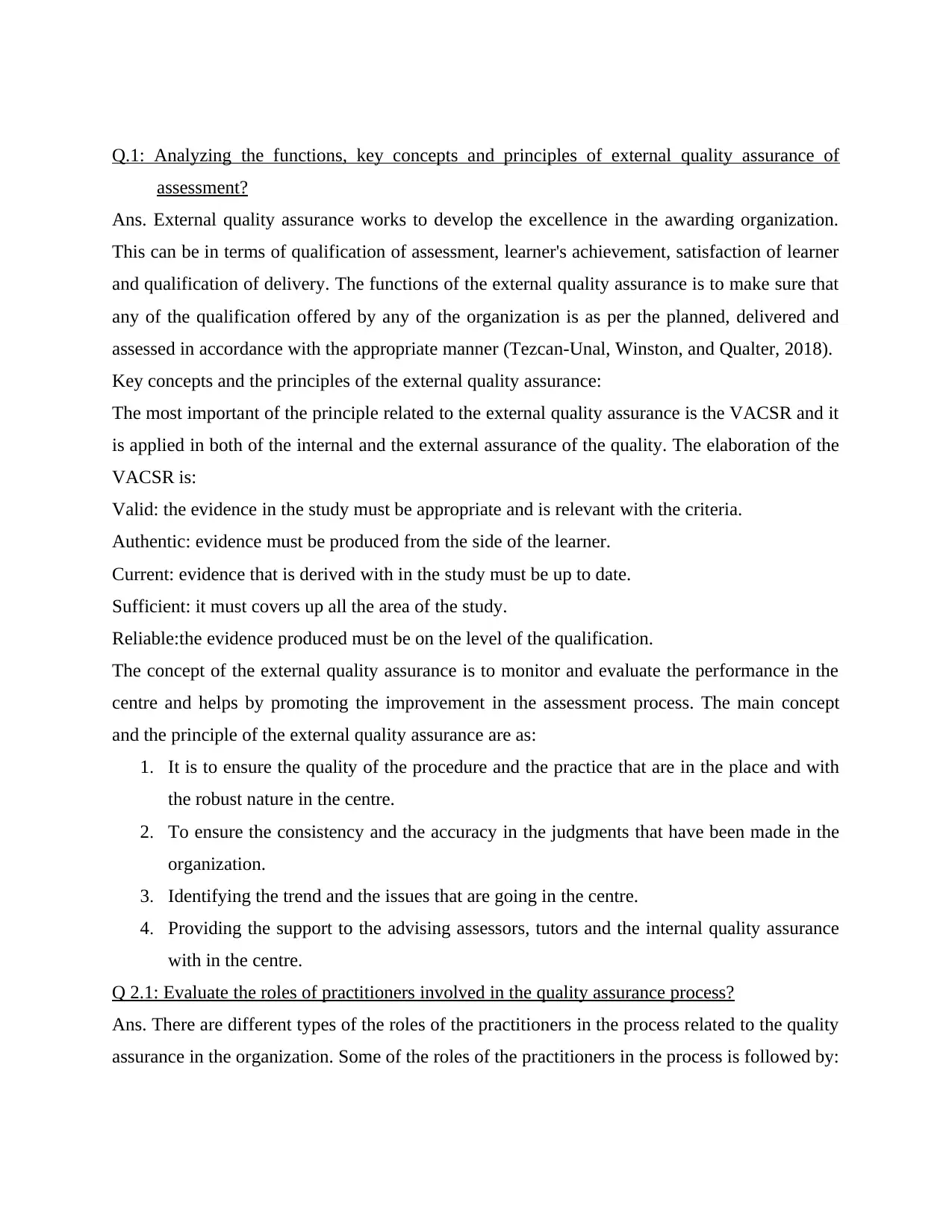
Q.1: Analyzing the functions, key concepts and principles of external quality assurance of
assessment?
Ans. External quality assurance works to develop the excellence in the awarding organization.
This can be in terms of qualification of assessment, learner's achievement, satisfaction of learner
and qualification of delivery. The functions of the external quality assurance is to make sure that
any of the qualification offered by any of the organization is as per the planned, delivered and
assessed in accordance with the appropriate manner (Tezcan-Unal, Winston, and Qualter, 2018).
Key concepts and the principles of the external quality assurance:
The most important of the principle related to the external quality assurance is the VACSR and it
is applied in both of the internal and the external assurance of the quality. The elaboration of the
VACSR is:
Valid: the evidence in the study must be appropriate and is relevant with the criteria.
Authentic: evidence must be produced from the side of the learner.
Current: evidence that is derived with in the study must be up to date.
Sufficient: it must covers up all the area of the study.
Reliable:the evidence produced must be on the level of the qualification.
The concept of the external quality assurance is to monitor and evaluate the performance in the
centre and helps by promoting the improvement in the assessment process. The main concept
and the principle of the external quality assurance are as:
1. It is to ensure the quality of the procedure and the practice that are in the place and with
the robust nature in the centre.
2. To ensure the consistency and the accuracy in the judgments that have been made in the
organization.
3. Identifying the trend and the issues that are going in the centre.
4. Providing the support to the advising assessors, tutors and the internal quality assurance
with in the centre.
Q 2.1: Evaluate the roles of practitioners involved in the quality assurance process?
Ans. There are different types of the roles of the practitioners in the process related to the quality
assurance in the organization. Some of the roles of the practitioners in the process is followed by:
assessment?
Ans. External quality assurance works to develop the excellence in the awarding organization.
This can be in terms of qualification of assessment, learner's achievement, satisfaction of learner
and qualification of delivery. The functions of the external quality assurance is to make sure that
any of the qualification offered by any of the organization is as per the planned, delivered and
assessed in accordance with the appropriate manner (Tezcan-Unal, Winston, and Qualter, 2018).
Key concepts and the principles of the external quality assurance:
The most important of the principle related to the external quality assurance is the VACSR and it
is applied in both of the internal and the external assurance of the quality. The elaboration of the
VACSR is:
Valid: the evidence in the study must be appropriate and is relevant with the criteria.
Authentic: evidence must be produced from the side of the learner.
Current: evidence that is derived with in the study must be up to date.
Sufficient: it must covers up all the area of the study.
Reliable:the evidence produced must be on the level of the qualification.
The concept of the external quality assurance is to monitor and evaluate the performance in the
centre and helps by promoting the improvement in the assessment process. The main concept
and the principle of the external quality assurance are as:
1. It is to ensure the quality of the procedure and the practice that are in the place and with
the robust nature in the centre.
2. To ensure the consistency and the accuracy in the judgments that have been made in the
organization.
3. Identifying the trend and the issues that are going in the centre.
4. Providing the support to the advising assessors, tutors and the internal quality assurance
with in the centre.
Q 2.1: Evaluate the roles of practitioners involved in the quality assurance process?
Ans. There are different types of the roles of the practitioners in the process related to the quality
assurance in the organization. Some of the roles of the practitioners in the process is followed by:
Secure Best Marks with AI Grader
Need help grading? Try our AI Grader for instant feedback on your assignments.
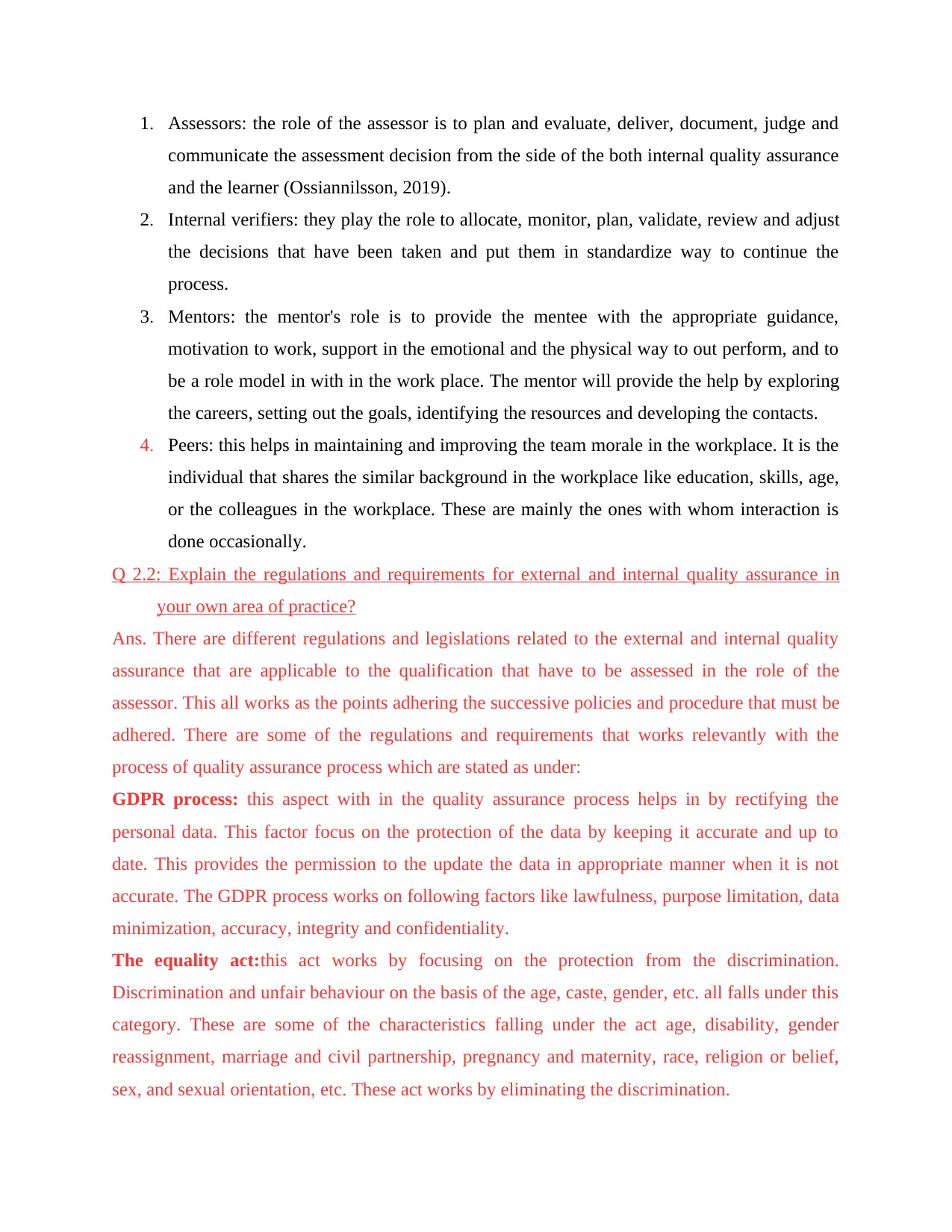
1. Assessors: the role of the assessor is to plan and evaluate, deliver, document, judge and
communicate the assessment decision from the side of the both internal quality assurance
and the learner (Ossiannilsson, 2019).
2. Internal verifiers: they play the role to allocate, monitor, plan, validate, review and adjust
the decisions that have been taken and put them in standardize way to continue the
process.
3. Mentors: the mentor's role is to provide the mentee with the appropriate guidance,
motivation to work, support in the emotional and the physical way to out perform, and to
be a role model in with in the work place. The mentor will provide the help by exploring
the careers, setting out the goals, identifying the resources and developing the contacts.
4. Peers: this helps in maintaining and improving the team morale in the workplace. It is the
individual that shares the similar background in the workplace like education, skills, age,
or the colleagues in the workplace. These are mainly the ones with whom interaction is
done occasionally.
Q 2.2: Explain the regulations and requirements for external and internal quality assurance in
your own area of practice?
Ans. There are different regulations and legislations related to the external and internal quality
assurance that are applicable to the qualification that have to be assessed in the role of the
assessor. This all works as the points adhering the successive policies and procedure that must be
adhered. There are some of the regulations and requirements that works relevantly with the
process of quality assurance process which are stated as under:
GDPR process: this aspect with in the quality assurance process helps in by rectifying the
personal data. This factor focus on the protection of the data by keeping it accurate and up to
date. This provides the permission to the update the data in appropriate manner when it is not
accurate. The GDPR process works on following factors like lawfulness, purpose limitation, data
minimization, accuracy, integrity and confidentiality.
The equality act:this act works by focusing on the protection from the discrimination.
Discrimination and unfair behaviour on the basis of the age, caste, gender, etc. all falls under this
category. These are some of the characteristics falling under the act age, disability, gender
reassignment, marriage and civil partnership, pregnancy and maternity, race, religion or belief,
sex, and sexual orientation, etc. These act works by eliminating the discrimination.
communicate the assessment decision from the side of the both internal quality assurance
and the learner (Ossiannilsson, 2019).
2. Internal verifiers: they play the role to allocate, monitor, plan, validate, review and adjust
the decisions that have been taken and put them in standardize way to continue the
process.
3. Mentors: the mentor's role is to provide the mentee with the appropriate guidance,
motivation to work, support in the emotional and the physical way to out perform, and to
be a role model in with in the work place. The mentor will provide the help by exploring
the careers, setting out the goals, identifying the resources and developing the contacts.
4. Peers: this helps in maintaining and improving the team morale in the workplace. It is the
individual that shares the similar background in the workplace like education, skills, age,
or the colleagues in the workplace. These are mainly the ones with whom interaction is
done occasionally.
Q 2.2: Explain the regulations and requirements for external and internal quality assurance in
your own area of practice?
Ans. There are different regulations and legislations related to the external and internal quality
assurance that are applicable to the qualification that have to be assessed in the role of the
assessor. This all works as the points adhering the successive policies and procedure that must be
adhered. There are some of the regulations and requirements that works relevantly with the
process of quality assurance process which are stated as under:
GDPR process: this aspect with in the quality assurance process helps in by rectifying the
personal data. This factor focus on the protection of the data by keeping it accurate and up to
date. This provides the permission to the update the data in appropriate manner when it is not
accurate. The GDPR process works on following factors like lawfulness, purpose limitation, data
minimization, accuracy, integrity and confidentiality.
The equality act:this act works by focusing on the protection from the discrimination.
Discrimination and unfair behaviour on the basis of the age, caste, gender, etc. all falls under this
category. These are some of the characteristics falling under the act age, disability, gender
reassignment, marriage and civil partnership, pregnancy and maternity, race, religion or belief,
sex, and sexual orientation, etc. These act works by eliminating the discrimination.
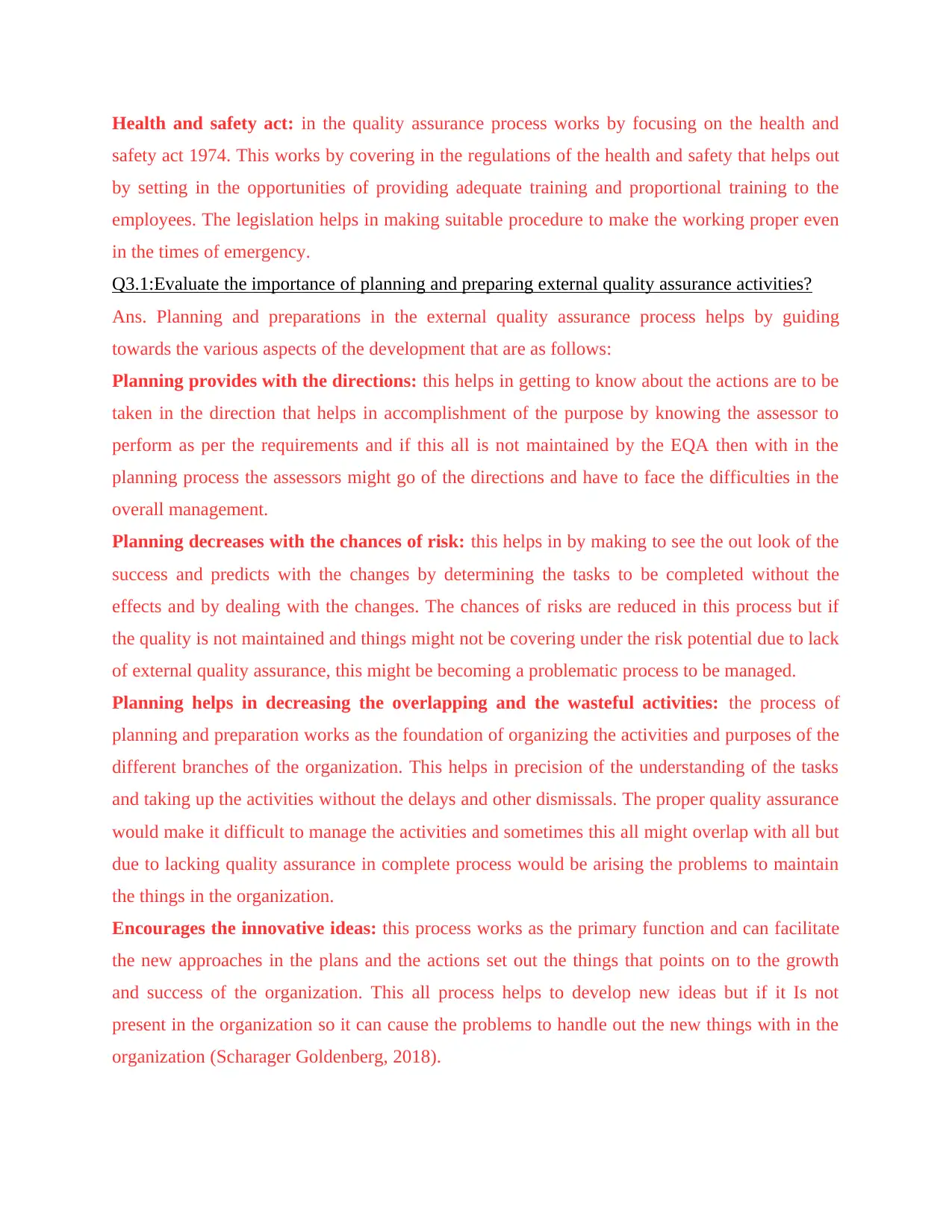
Health and safety act: in the quality assurance process works by focusing on the health and
safety act 1974. This works by covering in the regulations of the health and safety that helps out
by setting in the opportunities of providing adequate training and proportional training to the
employees. The legislation helps in making suitable procedure to make the working proper even
in the times of emergency.
Q3.1:Evaluate the importance of planning and preparing external quality assurance activities?
Ans. Planning and preparations in the external quality assurance process helps by guiding
towards the various aspects of the development that are as follows:
Planning provides with the directions: this helps in getting to know about the actions are to be
taken in the direction that helps in accomplishment of the purpose by knowing the assessor to
perform as per the requirements and if this all is not maintained by the EQA then with in the
planning process the assessors might go of the directions and have to face the difficulties in the
overall management.
Planning decreases with the chances of risk: this helps in by making to see the out look of the
success and predicts with the changes by determining the tasks to be completed without the
effects and by dealing with the changes. The chances of risks are reduced in this process but if
the quality is not maintained and things might not be covering under the risk potential due to lack
of external quality assurance, this might be becoming a problematic process to be managed.
Planning helps in decreasing the overlapping and the wasteful activities: the process of
planning and preparation works as the foundation of organizing the activities and purposes of the
different branches of the organization. This helps in precision of the understanding of the tasks
and taking up the activities without the delays and other dismissals. The proper quality assurance
would make it difficult to manage the activities and sometimes this all might overlap with all but
due to lacking quality assurance in complete process would be arising the problems to maintain
the things in the organization.
Encourages the innovative ideas: this process works as the primary function and can facilitate
the new approaches in the plans and the actions set out the things that points on to the growth
and success of the organization. This all process helps to develop new ideas but if it Is not
present in the organization so it can cause the problems to handle out the new things with in the
organization (Scharager Goldenberg, 2018).
safety act 1974. This works by covering in the regulations of the health and safety that helps out
by setting in the opportunities of providing adequate training and proportional training to the
employees. The legislation helps in making suitable procedure to make the working proper even
in the times of emergency.
Q3.1:Evaluate the importance of planning and preparing external quality assurance activities?
Ans. Planning and preparations in the external quality assurance process helps by guiding
towards the various aspects of the development that are as follows:
Planning provides with the directions: this helps in getting to know about the actions are to be
taken in the direction that helps in accomplishment of the purpose by knowing the assessor to
perform as per the requirements and if this all is not maintained by the EQA then with in the
planning process the assessors might go of the directions and have to face the difficulties in the
overall management.
Planning decreases with the chances of risk: this helps in by making to see the out look of the
success and predicts with the changes by determining the tasks to be completed without the
effects and by dealing with the changes. The chances of risks are reduced in this process but if
the quality is not maintained and things might not be covering under the risk potential due to lack
of external quality assurance, this might be becoming a problematic process to be managed.
Planning helps in decreasing the overlapping and the wasteful activities: the process of
planning and preparation works as the foundation of organizing the activities and purposes of the
different branches of the organization. This helps in precision of the understanding of the tasks
and taking up the activities without the delays and other dismissals. The proper quality assurance
would make it difficult to manage the activities and sometimes this all might overlap with all but
due to lacking quality assurance in complete process would be arising the problems to maintain
the things in the organization.
Encourages the innovative ideas: this process works as the primary function and can facilitate
the new approaches in the plans and the actions set out the things that points on to the growth
and success of the organization. This all process helps to develop new ideas but if it Is not
present in the organization so it can cause the problems to handle out the new things with in the
organization (Scharager Goldenberg, 2018).
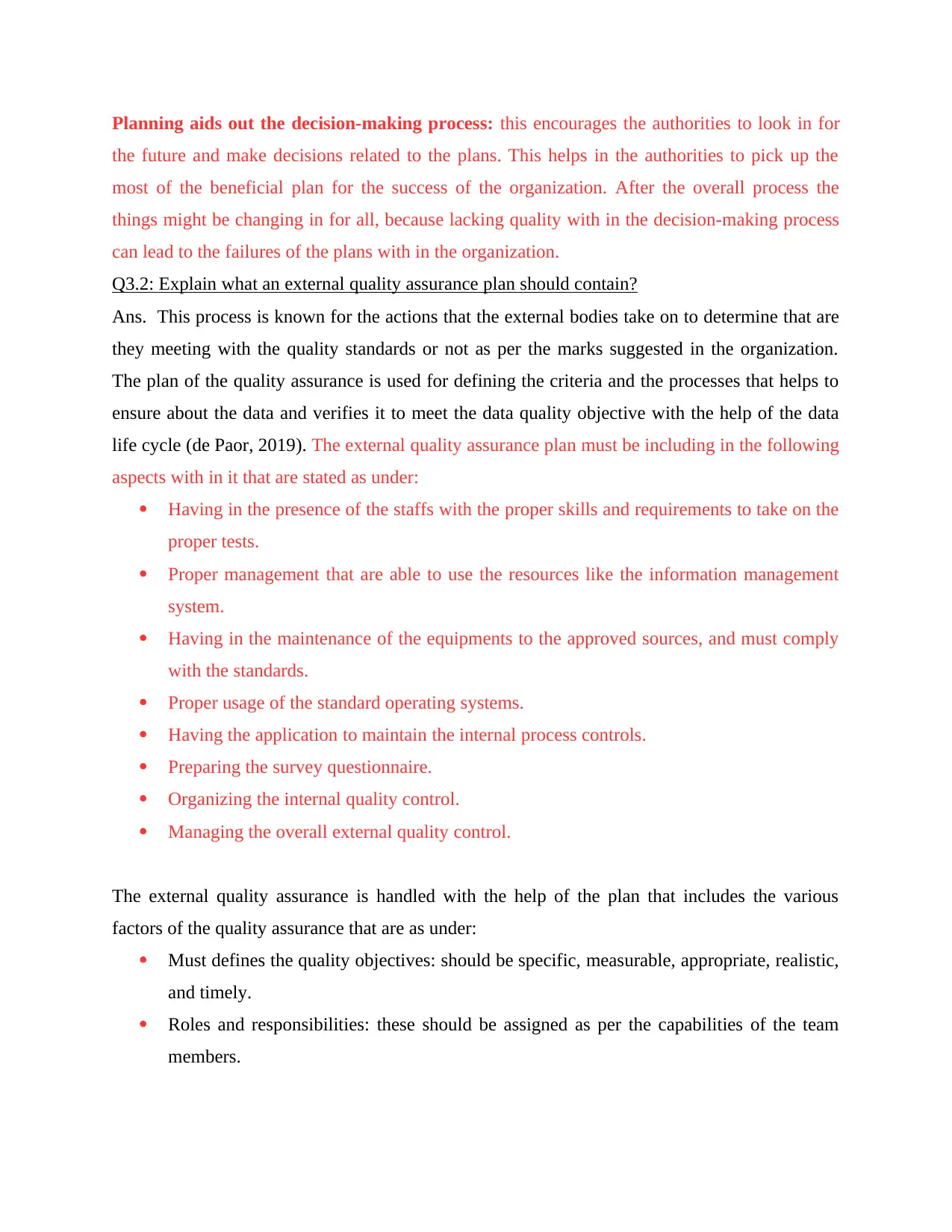
Planning aids out the decision-making process: this encourages the authorities to look in for
the future and make decisions related to the plans. This helps in the authorities to pick up the
most of the beneficial plan for the success of the organization. After the overall process the
things might be changing in for all, because lacking quality with in the decision-making process
can lead to the failures of the plans with in the organization.
Q3.2: Explain what an external quality assurance plan should contain?
Ans. This process is known for the actions that the external bodies take on to determine that are
they meeting with the quality standards or not as per the marks suggested in the organization.
The plan of the quality assurance is used for defining the criteria and the processes that helps to
ensure about the data and verifies it to meet the data quality objective with the help of the data
life cycle (de Paor, 2019). The external quality assurance plan must be including in the following
aspects with in it that are stated as under:
Having in the presence of the staffs with the proper skills and requirements to take on the
proper tests.
Proper management that are able to use the resources like the information management
system.
Having in the maintenance of the equipments to the approved sources, and must comply
with the standards.
Proper usage of the standard operating systems.
Having the application to maintain the internal process controls.
Preparing the survey questionnaire.
Organizing the internal quality control.
Managing the overall external quality control.
The external quality assurance is handled with the help of the plan that includes the various
factors of the quality assurance that are as under:
Must defines the quality objectives: should be specific, measurable, appropriate, realistic,
and timely.
Roles and responsibilities: these should be assigned as per the capabilities of the team
members.
the future and make decisions related to the plans. This helps in the authorities to pick up the
most of the beneficial plan for the success of the organization. After the overall process the
things might be changing in for all, because lacking quality with in the decision-making process
can lead to the failures of the plans with in the organization.
Q3.2: Explain what an external quality assurance plan should contain?
Ans. This process is known for the actions that the external bodies take on to determine that are
they meeting with the quality standards or not as per the marks suggested in the organization.
The plan of the quality assurance is used for defining the criteria and the processes that helps to
ensure about the data and verifies it to meet the data quality objective with the help of the data
life cycle (de Paor, 2019). The external quality assurance plan must be including in the following
aspects with in it that are stated as under:
Having in the presence of the staffs with the proper skills and requirements to take on the
proper tests.
Proper management that are able to use the resources like the information management
system.
Having in the maintenance of the equipments to the approved sources, and must comply
with the standards.
Proper usage of the standard operating systems.
Having the application to maintain the internal process controls.
Preparing the survey questionnaire.
Organizing the internal quality control.
Managing the overall external quality control.
The external quality assurance is handled with the help of the plan that includes the various
factors of the quality assurance that are as under:
Must defines the quality objectives: should be specific, measurable, appropriate, realistic,
and timely.
Roles and responsibilities: these should be assigned as per the capabilities of the team
members.
Paraphrase This Document
Need a fresh take? Get an instant paraphrase of this document with our AI Paraphraser
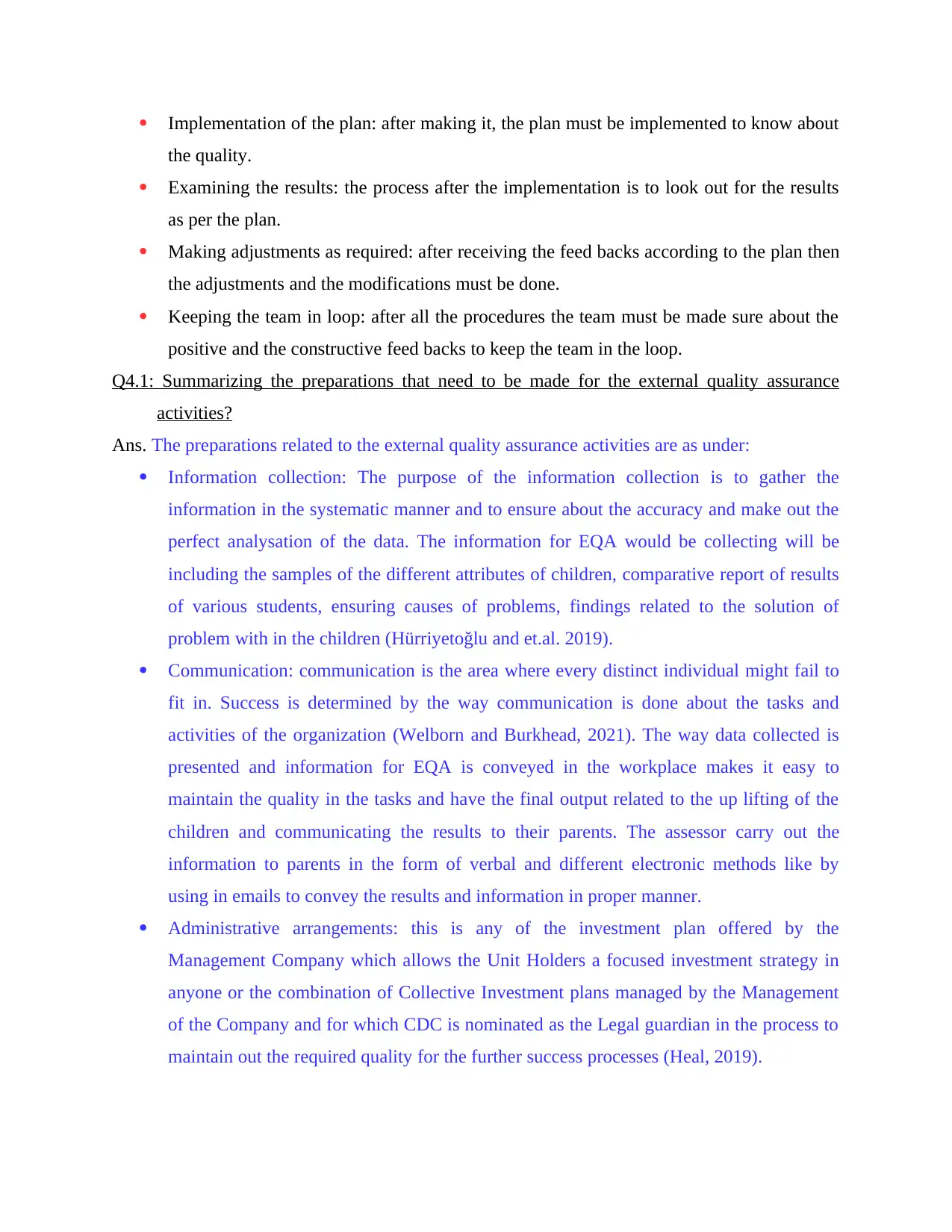
Implementation of the plan: after making it, the plan must be implemented to know about
the quality.
Examining the results: the process after the implementation is to look out for the results
as per the plan.
Making adjustments as required: after receiving the feed backs according to the plan then
the adjustments and the modifications must be done.
Keeping the team in loop: after all the procedures the team must be made sure about the
positive and the constructive feed backs to keep the team in the loop.
Q4.1: Summarizing the preparations that need to be made for the external quality assurance
activities?
Ans. The preparations related to the external quality assurance activities are as under:
Information collection: The purpose of the information collection is to gather the
information in the systematic manner and to ensure about the accuracy and make out the
perfect analysation of the data. The information for EQA would be collecting will be
including the samples of the different attributes of children, comparative report of results
of various students, ensuring causes of problems, findings related to the solution of
problem with in the children (Hürriyetoğlu and et.al. 2019).
Communication: communication is the area where every distinct individual might fail to
fit in. Success is determined by the way communication is done about the tasks and
activities of the organization (Welborn and Burkhead, 2021). The way data collected is
presented and information for EQA is conveyed in the workplace makes it easy to
maintain the quality in the tasks and have the final output related to the up lifting of the
children and communicating the results to their parents. The assessor carry out the
information to parents in the form of verbal and different electronic methods like by
using in emails to convey the results and information in proper manner.
Administrative arrangements: this is any of the investment plan offered by the
Management Company which allows the Unit Holders a focused investment strategy in
anyone or the combination of Collective Investment plans managed by the Management
of the Company and for which CDC is nominated as the Legal guardian in the process to
maintain out the required quality for the further success processes (Heal, 2019).
the quality.
Examining the results: the process after the implementation is to look out for the results
as per the plan.
Making adjustments as required: after receiving the feed backs according to the plan then
the adjustments and the modifications must be done.
Keeping the team in loop: after all the procedures the team must be made sure about the
positive and the constructive feed backs to keep the team in the loop.
Q4.1: Summarizing the preparations that need to be made for the external quality assurance
activities?
Ans. The preparations related to the external quality assurance activities are as under:
Information collection: The purpose of the information collection is to gather the
information in the systematic manner and to ensure about the accuracy and make out the
perfect analysation of the data. The information for EQA would be collecting will be
including the samples of the different attributes of children, comparative report of results
of various students, ensuring causes of problems, findings related to the solution of
problem with in the children (Hürriyetoğlu and et.al. 2019).
Communication: communication is the area where every distinct individual might fail to
fit in. Success is determined by the way communication is done about the tasks and
activities of the organization (Welborn and Burkhead, 2021). The way data collected is
presented and information for EQA is conveyed in the workplace makes it easy to
maintain the quality in the tasks and have the final output related to the up lifting of the
children and communicating the results to their parents. The assessor carry out the
information to parents in the form of verbal and different electronic methods like by
using in emails to convey the results and information in proper manner.
Administrative arrangements: this is any of the investment plan offered by the
Management Company which allows the Unit Holders a focused investment strategy in
anyone or the combination of Collective Investment plans managed by the Management
of the Company and for which CDC is nominated as the Legal guardian in the process to
maintain out the required quality for the further success processes (Heal, 2019).
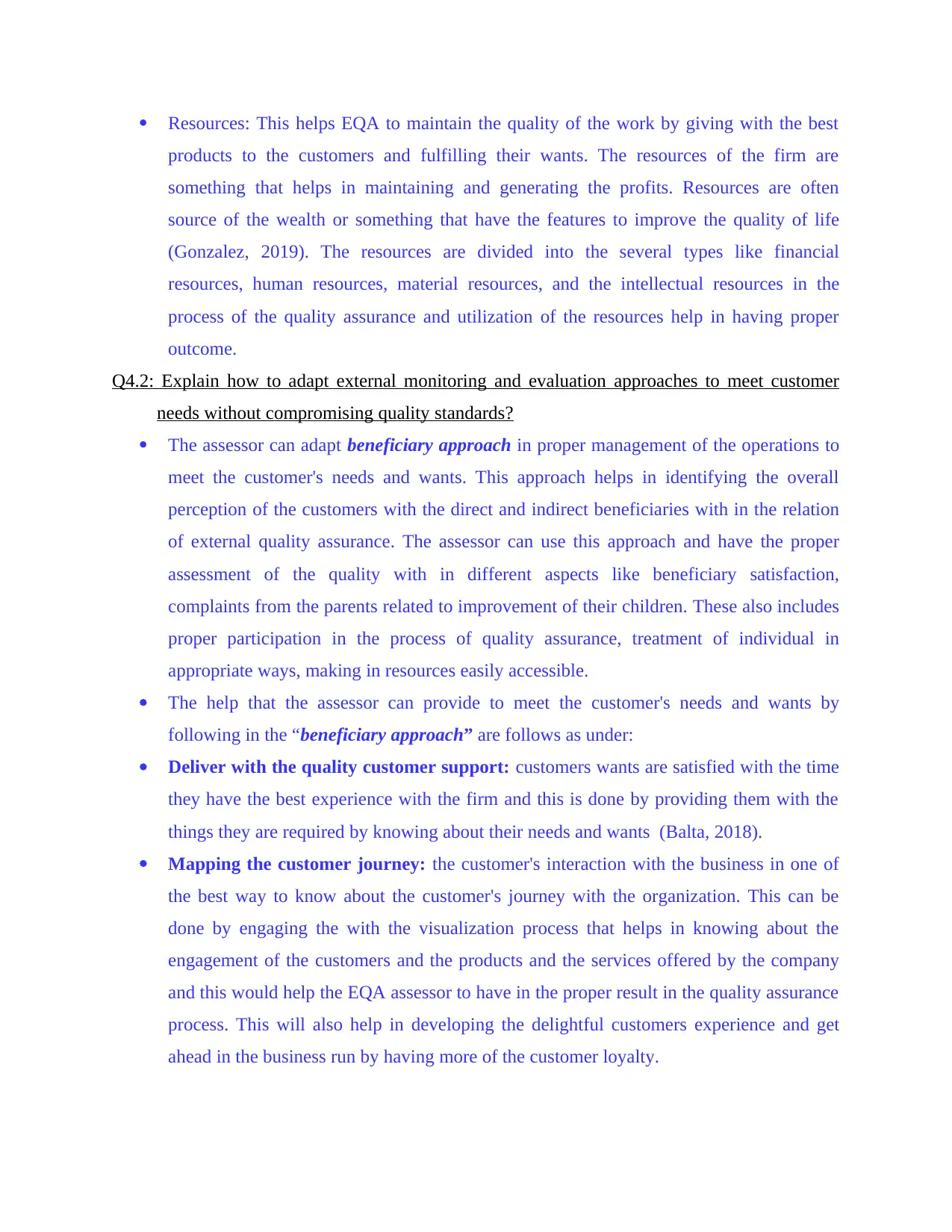
Resources: This helps EQA to maintain the quality of the work by giving with the best
products to the customers and fulfilling their wants. The resources of the firm are
something that helps in maintaining and generating the profits. Resources are often
source of the wealth or something that have the features to improve the quality of life
(Gonzalez, 2019). The resources are divided into the several types like financial
resources, human resources, material resources, and the intellectual resources in the
process of the quality assurance and utilization of the resources help in having proper
outcome.
Q4.2: Explain how to adapt external monitoring and evaluation approaches to meet customer
needs without compromising quality standards?
The assessor can adapt beneficiary approach in proper management of the operations to
meet the customer's needs and wants. This approach helps in identifying the overall
perception of the customers with the direct and indirect beneficiaries with in the relation
of external quality assurance. The assessor can use this approach and have the proper
assessment of the quality with in different aspects like beneficiary satisfaction,
complaints from the parents related to improvement of their children. These also includes
proper participation in the process of quality assurance, treatment of individual in
appropriate ways, making in resources easily accessible.
The help that the assessor can provide to meet the customer's needs and wants by
following in the “beneficiary approach” are follows as under:
Deliver with the quality customer support: customers wants are satisfied with the time
they have the best experience with the firm and this is done by providing them with the
things they are required by knowing about their needs and wants (Balta, 2018).
Mapping the customer journey: the customer's interaction with the business in one of
the best way to know about the customer's journey with the organization. This can be
done by engaging the with the visualization process that helps in knowing about the
engagement of the customers and the products and the services offered by the company
and this would help the EQA assessor to have in the proper result in the quality assurance
process. This will also help in developing the delightful customers experience and get
ahead in the business run by having more of the customer loyalty.
products to the customers and fulfilling their wants. The resources of the firm are
something that helps in maintaining and generating the profits. Resources are often
source of the wealth or something that have the features to improve the quality of life
(Gonzalez, 2019). The resources are divided into the several types like financial
resources, human resources, material resources, and the intellectual resources in the
process of the quality assurance and utilization of the resources help in having proper
outcome.
Q4.2: Explain how to adapt external monitoring and evaluation approaches to meet customer
needs without compromising quality standards?
The assessor can adapt beneficiary approach in proper management of the operations to
meet the customer's needs and wants. This approach helps in identifying the overall
perception of the customers with the direct and indirect beneficiaries with in the relation
of external quality assurance. The assessor can use this approach and have the proper
assessment of the quality with in different aspects like beneficiary satisfaction,
complaints from the parents related to improvement of their children. These also includes
proper participation in the process of quality assurance, treatment of individual in
appropriate ways, making in resources easily accessible.
The help that the assessor can provide to meet the customer's needs and wants by
following in the “beneficiary approach” are follows as under:
Deliver with the quality customer support: customers wants are satisfied with the time
they have the best experience with the firm and this is done by providing them with the
things they are required by knowing about their needs and wants (Balta, 2018).
Mapping the customer journey: the customer's interaction with the business in one of
the best way to know about the customer's journey with the organization. This can be
done by engaging the with the visualization process that helps in knowing about the
engagement of the customers and the products and the services offered by the company
and this would help the EQA assessor to have in the proper result in the quality assurance
process. This will also help in developing the delightful customers experience and get
ahead in the business run by having more of the customer loyalty.
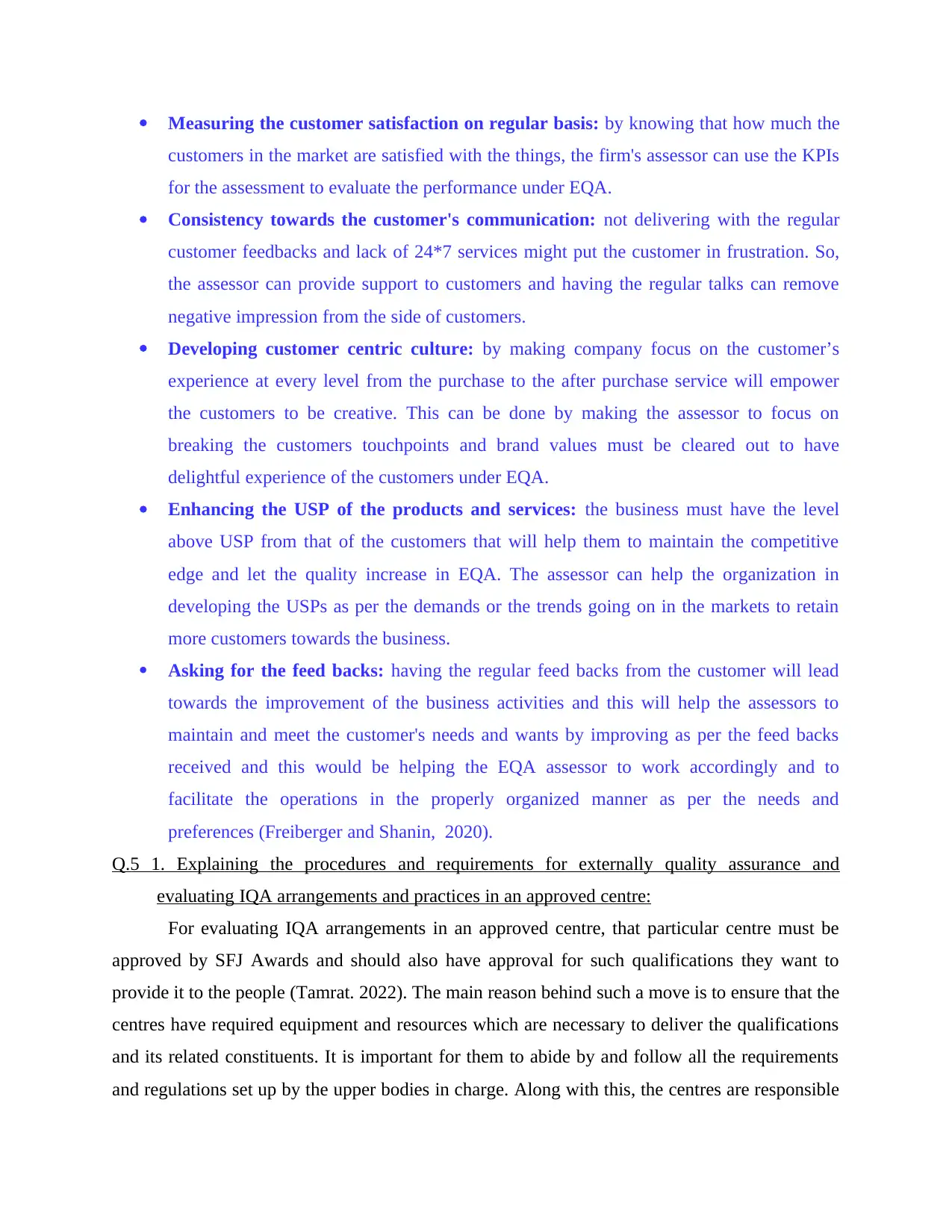
Measuring the customer satisfaction on regular basis: by knowing that how much the
customers in the market are satisfied with the things, the firm's assessor can use the KPIs
for the assessment to evaluate the performance under EQA.
Consistency towards the customer's communication: not delivering with the regular
customer feedbacks and lack of 24*7 services might put the customer in frustration. So,
the assessor can provide support to customers and having the regular talks can remove
negative impression from the side of customers.
Developing customer centric culture: by making company focus on the customer’s
experience at every level from the purchase to the after purchase service will empower
the customers to be creative. This can be done by making the assessor to focus on
breaking the customers touchpoints and brand values must be cleared out to have
delightful experience of the customers under EQA.
Enhancing the USP of the products and services: the business must have the level
above USP from that of the customers that will help them to maintain the competitive
edge and let the quality increase in EQA. The assessor can help the organization in
developing the USPs as per the demands or the trends going on in the markets to retain
more customers towards the business.
Asking for the feed backs: having the regular feed backs from the customer will lead
towards the improvement of the business activities and this will help the assessors to
maintain and meet the customer's needs and wants by improving as per the feed backs
received and this would be helping the EQA assessor to work accordingly and to
facilitate the operations in the properly organized manner as per the needs and
preferences (Freiberger and Shanin, 2020).
Q.5 1. Explaining the procedures and requirements for externally quality assurance and
evaluating IQA arrangements and practices in an approved centre:
For evaluating IQA arrangements in an approved centre, that particular centre must be
approved by SFJ Awards and should also have approval for such qualifications they want to
provide it to the people (Tamrat. 2022). The main reason behind such a move is to ensure that the
centres have required equipment and resources which are necessary to deliver the qualifications
and its related constituents. It is important for them to abide by and follow all the requirements
and regulations set up by the upper bodies in charge. Along with this, the centres are responsible
customers in the market are satisfied with the things, the firm's assessor can use the KPIs
for the assessment to evaluate the performance under EQA.
Consistency towards the customer's communication: not delivering with the regular
customer feedbacks and lack of 24*7 services might put the customer in frustration. So,
the assessor can provide support to customers and having the regular talks can remove
negative impression from the side of customers.
Developing customer centric culture: by making company focus on the customer’s
experience at every level from the purchase to the after purchase service will empower
the customers to be creative. This can be done by making the assessor to focus on
breaking the customers touchpoints and brand values must be cleared out to have
delightful experience of the customers under EQA.
Enhancing the USP of the products and services: the business must have the level
above USP from that of the customers that will help them to maintain the competitive
edge and let the quality increase in EQA. The assessor can help the organization in
developing the USPs as per the demands or the trends going on in the markets to retain
more customers towards the business.
Asking for the feed backs: having the regular feed backs from the customer will lead
towards the improvement of the business activities and this will help the assessors to
maintain and meet the customer's needs and wants by improving as per the feed backs
received and this would be helping the EQA assessor to work accordingly and to
facilitate the operations in the properly organized manner as per the needs and
preferences (Freiberger and Shanin, 2020).
Q.5 1. Explaining the procedures and requirements for externally quality assurance and
evaluating IQA arrangements and practices in an approved centre:
For evaluating IQA arrangements in an approved centre, that particular centre must be
approved by SFJ Awards and should also have approval for such qualifications they want to
provide it to the people (Tamrat. 2022). The main reason behind such a move is to ensure that the
centres have required equipment and resources which are necessary to deliver the qualifications
and its related constituents. It is important for them to abide by and follow all the requirements
and regulations set up by the upper bodies in charge. Along with this, the centres are responsible
Secure Best Marks with AI Grader
Need help grading? Try our AI Grader for instant feedback on your assignments.
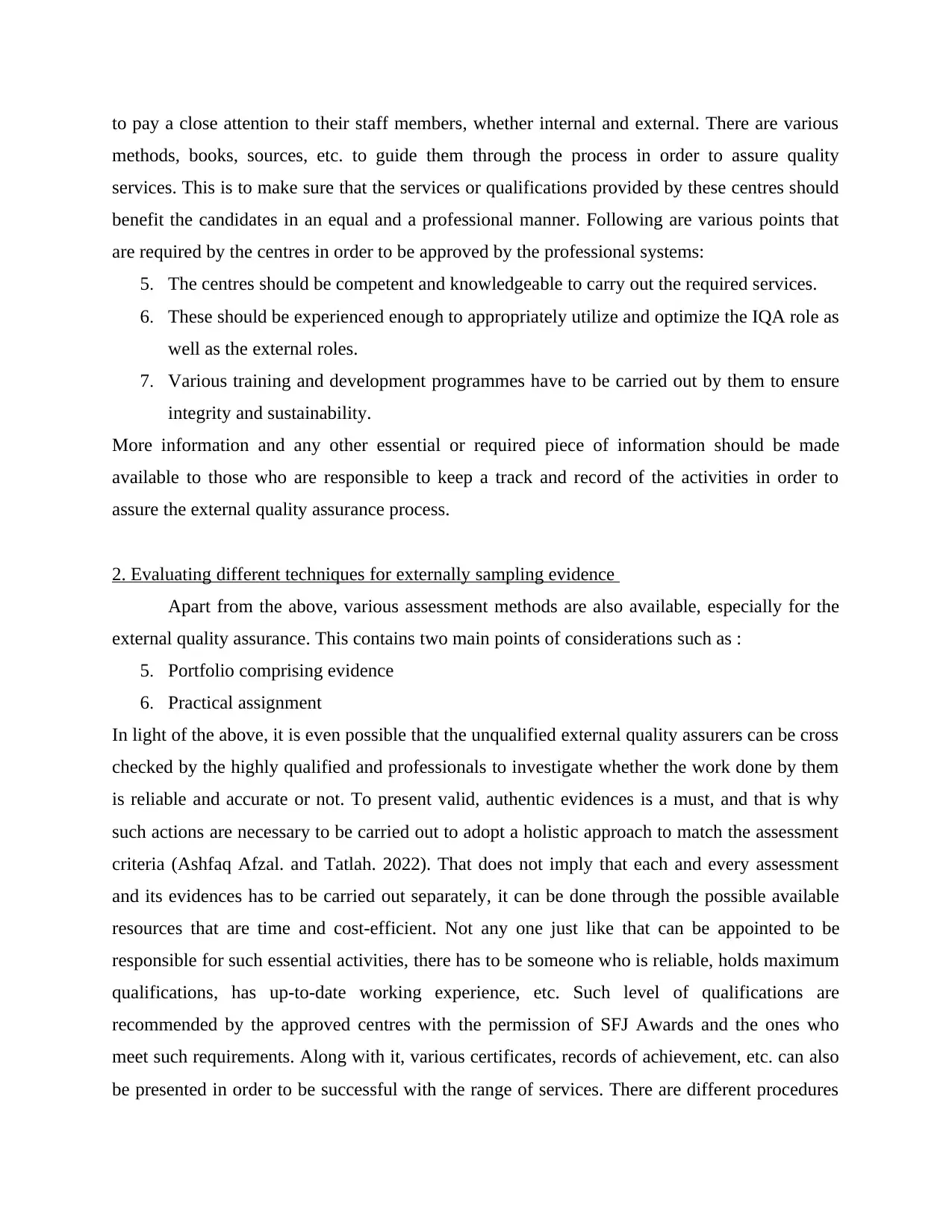
to pay a close attention to their staff members, whether internal and external. There are various
methods, books, sources, etc. to guide them through the process in order to assure quality
services. This is to make sure that the services or qualifications provided by these centres should
benefit the candidates in an equal and a professional manner. Following are various points that
are required by the centres in order to be approved by the professional systems:
5. The centres should be competent and knowledgeable to carry out the required services.
6. These should be experienced enough to appropriately utilize and optimize the IQA role as
well as the external roles.
7. Various training and development programmes have to be carried out by them to ensure
integrity and sustainability.
More information and any other essential or required piece of information should be made
available to those who are responsible to keep a track and record of the activities in order to
assure the external quality assurance process.
2. Evaluating different techniques for externally sampling evidence
Apart from the above, various assessment methods are also available, especially for the
external quality assurance. This contains two main points of considerations such as :
5. Portfolio comprising evidence
6. Practical assignment
In light of the above, it is even possible that the unqualified external quality assurers can be cross
checked by the highly qualified and professionals to investigate whether the work done by them
is reliable and accurate or not. To present valid, authentic evidences is a must, and that is why
such actions are necessary to be carried out to adopt a holistic approach to match the assessment
criteria (Ashfaq Afzal. and Tatlah. 2022). That does not imply that each and every assessment
and its evidences has to be carried out separately, it can be done through the possible available
resources that are time and cost-efficient. Not any one just like that can be appointed to be
responsible for such essential activities, there has to be someone who is reliable, holds maximum
qualifications, has up-to-date working experience, etc. Such level of qualifications are
recommended by the approved centres with the permission of SFJ Awards and the ones who
meet such requirements. Along with it, various certificates, records of achievement, etc. can also
be presented in order to be successful with the range of services. There are different procedures
methods, books, sources, etc. to guide them through the process in order to assure quality
services. This is to make sure that the services or qualifications provided by these centres should
benefit the candidates in an equal and a professional manner. Following are various points that
are required by the centres in order to be approved by the professional systems:
5. The centres should be competent and knowledgeable to carry out the required services.
6. These should be experienced enough to appropriately utilize and optimize the IQA role as
well as the external roles.
7. Various training and development programmes have to be carried out by them to ensure
integrity and sustainability.
More information and any other essential or required piece of information should be made
available to those who are responsible to keep a track and record of the activities in order to
assure the external quality assurance process.
2. Evaluating different techniques for externally sampling evidence
Apart from the above, various assessment methods are also available, especially for the
external quality assurance. This contains two main points of considerations such as :
5. Portfolio comprising evidence
6. Practical assignment
In light of the above, it is even possible that the unqualified external quality assurers can be cross
checked by the highly qualified and professionals to investigate whether the work done by them
is reliable and accurate or not. To present valid, authentic evidences is a must, and that is why
such actions are necessary to be carried out to adopt a holistic approach to match the assessment
criteria (Ashfaq Afzal. and Tatlah. 2022). That does not imply that each and every assessment
and its evidences has to be carried out separately, it can be done through the possible available
resources that are time and cost-efficient. Not any one just like that can be appointed to be
responsible for such essential activities, there has to be someone who is reliable, holds maximum
qualifications, has up-to-date working experience, etc. Such level of qualifications are
recommended by the approved centres with the permission of SFJ Awards and the ones who
meet such requirements. Along with it, various certificates, records of achievement, etc. can also
be presented in order to be successful with the range of services. There are different procedures
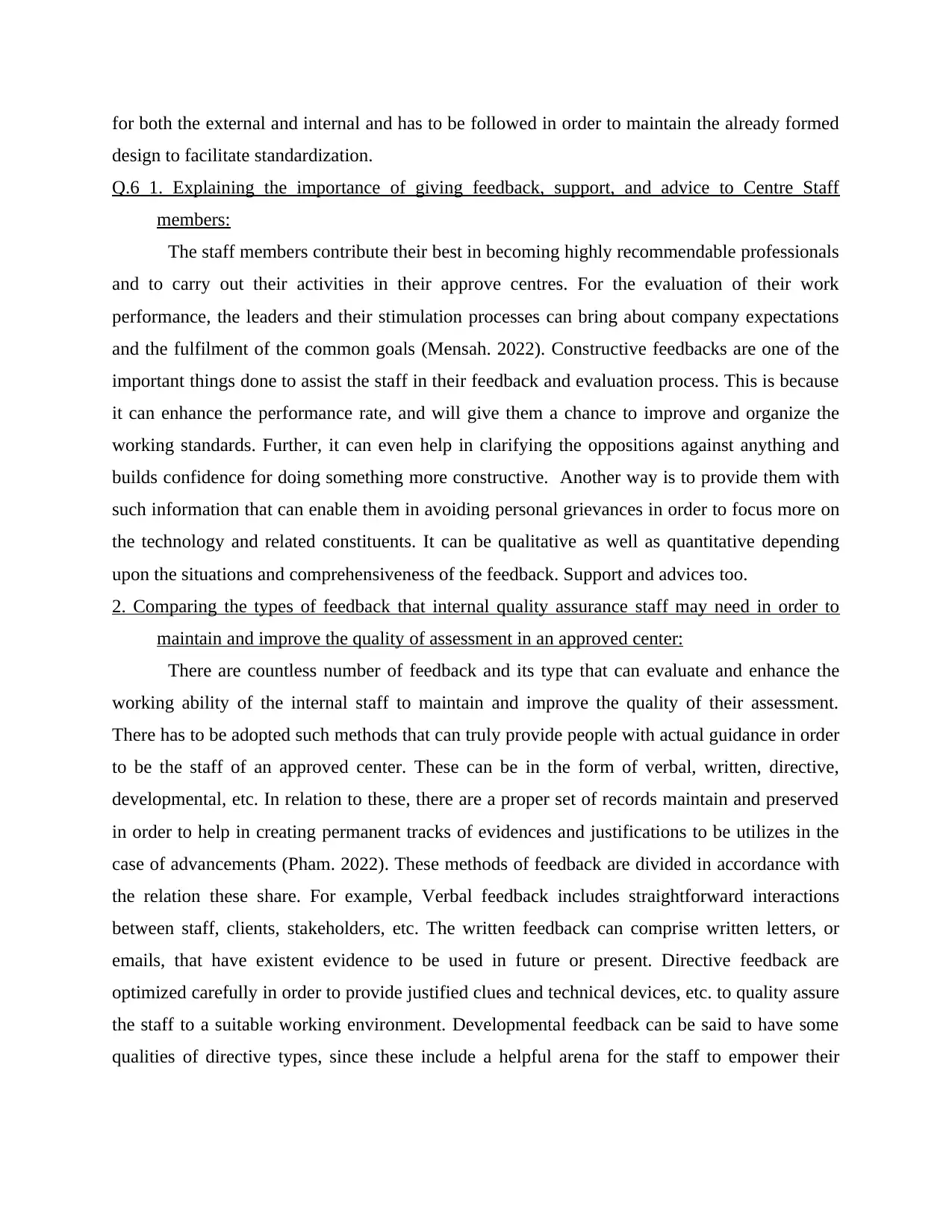
for both the external and internal and has to be followed in order to maintain the already formed
design to facilitate standardization.
Q.6 1. Explaining the importance of giving feedback, support, and advice to Centre Staff
members:
The staff members contribute their best in becoming highly recommendable professionals
and to carry out their activities in their approve centres. For the evaluation of their work
performance, the leaders and their stimulation processes can bring about company expectations
and the fulfilment of the common goals (Mensah. 2022). Constructive feedbacks are one of the
important things done to assist the staff in their feedback and evaluation process. This is because
it can enhance the performance rate, and will give them a chance to improve and organize the
working standards. Further, it can even help in clarifying the oppositions against anything and
builds confidence for doing something more constructive. Another way is to provide them with
such information that can enable them in avoiding personal grievances in order to focus more on
the technology and related constituents. It can be qualitative as well as quantitative depending
upon the situations and comprehensiveness of the feedback. Support and advices too.
2. Comparing the types of feedback that internal quality assurance staff may need in order to
maintain and improve the quality of assessment in an approved center:
There are countless number of feedback and its type that can evaluate and enhance the
working ability of the internal staff to maintain and improve the quality of their assessment.
There has to be adopted such methods that can truly provide people with actual guidance in order
to be the staff of an approved center. These can be in the form of verbal, written, directive,
developmental, etc. In relation to these, there are a proper set of records maintain and preserved
in order to help in creating permanent tracks of evidences and justifications to be utilizes in the
case of advancements (Pham. 2022). These methods of feedback are divided in accordance with
the relation these share. For example, Verbal feedback includes straightforward interactions
between staff, clients, stakeholders, etc. The written feedback can comprise written letters, or
emails, that have existent evidence to be used in future or present. Directive feedback are
optimized carefully in order to provide justified clues and technical devices, etc. to quality assure
the staff to a suitable working environment. Developmental feedback can be said to have some
qualities of directive types, since these include a helpful arena for the staff to empower their
design to facilitate standardization.
Q.6 1. Explaining the importance of giving feedback, support, and advice to Centre Staff
members:
The staff members contribute their best in becoming highly recommendable professionals
and to carry out their activities in their approve centres. For the evaluation of their work
performance, the leaders and their stimulation processes can bring about company expectations
and the fulfilment of the common goals (Mensah. 2022). Constructive feedbacks are one of the
important things done to assist the staff in their feedback and evaluation process. This is because
it can enhance the performance rate, and will give them a chance to improve and organize the
working standards. Further, it can even help in clarifying the oppositions against anything and
builds confidence for doing something more constructive. Another way is to provide them with
such information that can enable them in avoiding personal grievances in order to focus more on
the technology and related constituents. It can be qualitative as well as quantitative depending
upon the situations and comprehensiveness of the feedback. Support and advices too.
2. Comparing the types of feedback that internal quality assurance staff may need in order to
maintain and improve the quality of assessment in an approved center:
There are countless number of feedback and its type that can evaluate and enhance the
working ability of the internal staff to maintain and improve the quality of their assessment.
There has to be adopted such methods that can truly provide people with actual guidance in order
to be the staff of an approved center. These can be in the form of verbal, written, directive,
developmental, etc. In relation to these, there are a proper set of records maintain and preserved
in order to help in creating permanent tracks of evidences and justifications to be utilizes in the
case of advancements (Pham. 2022). These methods of feedback are divided in accordance with
the relation these share. For example, Verbal feedback includes straightforward interactions
between staff, clients, stakeholders, etc. The written feedback can comprise written letters, or
emails, that have existent evidence to be used in future or present. Directive feedback are
optimized carefully in order to provide justified clues and technical devices, etc. to quality assure
the staff to a suitable working environment. Developmental feedback can be said to have some
qualities of directive types, since these include a helpful arena for the staff to empower their
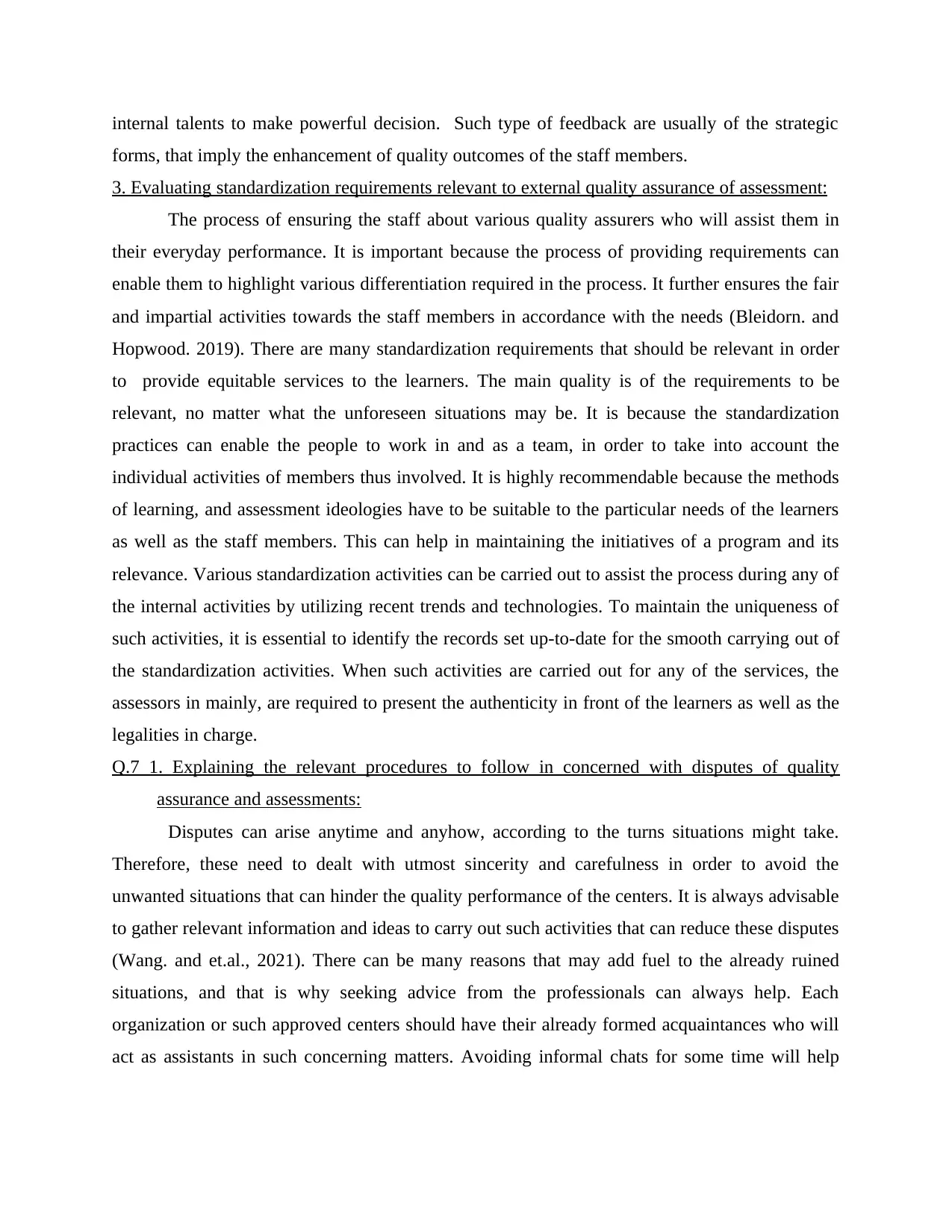
internal talents to make powerful decision. Such type of feedback are usually of the strategic
forms, that imply the enhancement of quality outcomes of the staff members.
3. Evaluating standardization requirements relevant to external quality assurance of assessment:
The process of ensuring the staff about various quality assurers who will assist them in
their everyday performance. It is important because the process of providing requirements can
enable them to highlight various differentiation required in the process. It further ensures the fair
and impartial activities towards the staff members in accordance with the needs (Bleidorn. and
Hopwood. 2019). There are many standardization requirements that should be relevant in order
to provide equitable services to the learners. The main quality is of the requirements to be
relevant, no matter what the unforeseen situations may be. It is because the standardization
practices can enable the people to work in and as a team, in order to take into account the
individual activities of members thus involved. It is highly recommendable because the methods
of learning, and assessment ideologies have to be suitable to the particular needs of the learners
as well as the staff members. This can help in maintaining the initiatives of a program and its
relevance. Various standardization activities can be carried out to assist the process during any of
the internal activities by utilizing recent trends and technologies. To maintain the uniqueness of
such activities, it is essential to identify the records set up-to-date for the smooth carrying out of
the standardization activities. When such activities are carried out for any of the services, the
assessors in mainly, are required to present the authenticity in front of the learners as well as the
legalities in charge.
Q.7 1. Explaining the relevant procedures to follow in concerned with disputes of quality
assurance and assessments:
Disputes can arise anytime and anyhow, according to the turns situations might take.
Therefore, these need to dealt with utmost sincerity and carefulness in order to avoid the
unwanted situations that can hinder the quality performance of the centers. It is always advisable
to gather relevant information and ideas to carry out such activities that can reduce these disputes
(Wang. and et.al., 2021). There can be many reasons that may add fuel to the already ruined
situations, and that is why seeking advice from the professionals can always help. Each
organization or such approved centers should have their already formed acquaintances who will
act as assistants in such concerning matters. Avoiding informal chats for some time will help
forms, that imply the enhancement of quality outcomes of the staff members.
3. Evaluating standardization requirements relevant to external quality assurance of assessment:
The process of ensuring the staff about various quality assurers who will assist them in
their everyday performance. It is important because the process of providing requirements can
enable them to highlight various differentiation required in the process. It further ensures the fair
and impartial activities towards the staff members in accordance with the needs (Bleidorn. and
Hopwood. 2019). There are many standardization requirements that should be relevant in order
to provide equitable services to the learners. The main quality is of the requirements to be
relevant, no matter what the unforeseen situations may be. It is because the standardization
practices can enable the people to work in and as a team, in order to take into account the
individual activities of members thus involved. It is highly recommendable because the methods
of learning, and assessment ideologies have to be suitable to the particular needs of the learners
as well as the staff members. This can help in maintaining the initiatives of a program and its
relevance. Various standardization activities can be carried out to assist the process during any of
the internal activities by utilizing recent trends and technologies. To maintain the uniqueness of
such activities, it is essential to identify the records set up-to-date for the smooth carrying out of
the standardization activities. When such activities are carried out for any of the services, the
assessors in mainly, are required to present the authenticity in front of the learners as well as the
legalities in charge.
Q.7 1. Explaining the relevant procedures to follow in concerned with disputes of quality
assurance and assessments:
Disputes can arise anytime and anyhow, according to the turns situations might take.
Therefore, these need to dealt with utmost sincerity and carefulness in order to avoid the
unwanted situations that can hinder the quality performance of the centers. It is always advisable
to gather relevant information and ideas to carry out such activities that can reduce these disputes
(Wang. and et.al., 2021). There can be many reasons that may add fuel to the already ruined
situations, and that is why seeking advice from the professionals can always help. Each
organization or such approved centers should have their already formed acquaintances who will
act as assistants in such concerning matters. Avoiding informal chats for some time will help
Paraphrase This Document
Need a fresh take? Get an instant paraphrase of this document with our AI Paraphraser
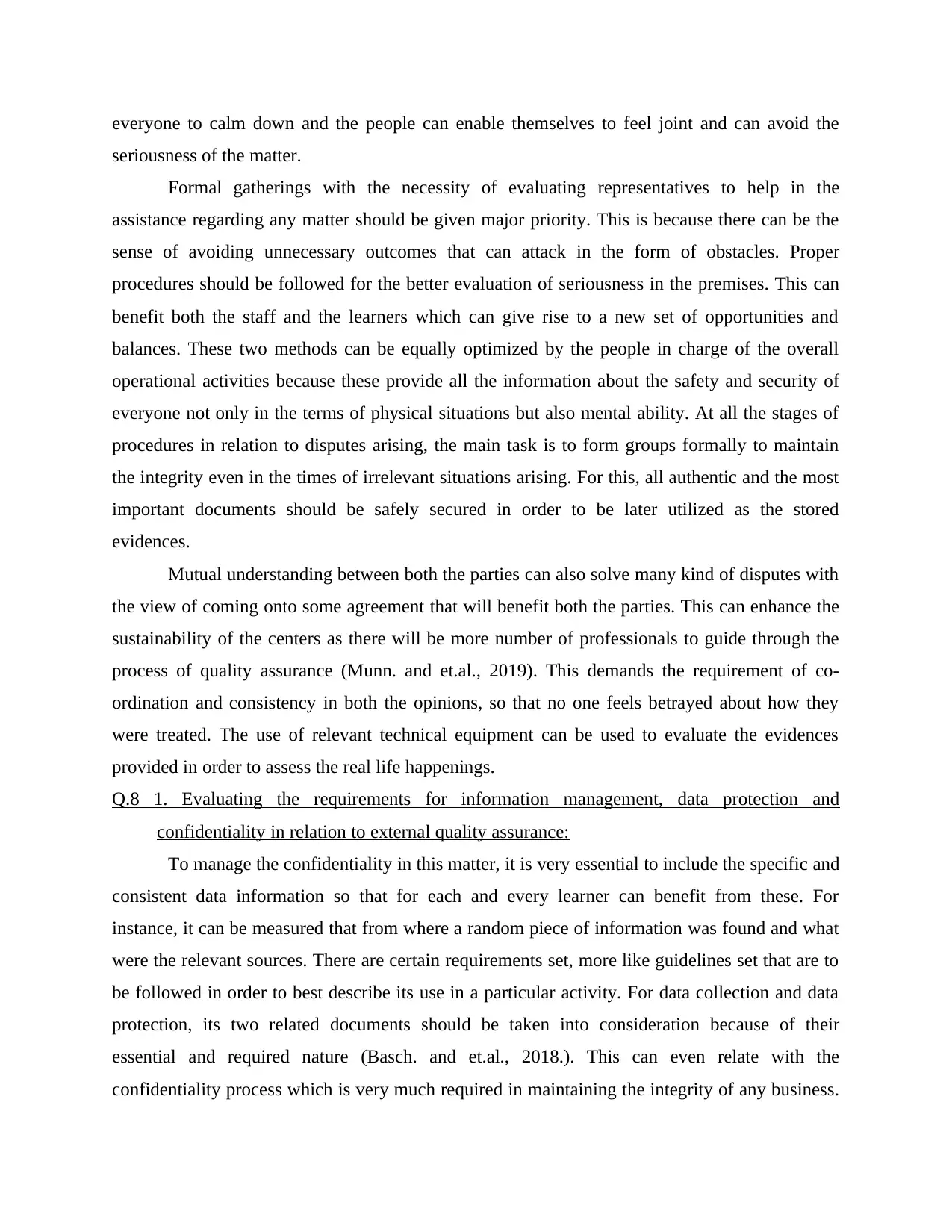
everyone to calm down and the people can enable themselves to feel joint and can avoid the
seriousness of the matter.
Formal gatherings with the necessity of evaluating representatives to help in the
assistance regarding any matter should be given major priority. This is because there can be the
sense of avoiding unnecessary outcomes that can attack in the form of obstacles. Proper
procedures should be followed for the better evaluation of seriousness in the premises. This can
benefit both the staff and the learners which can give rise to a new set of opportunities and
balances. These two methods can be equally optimized by the people in charge of the overall
operational activities because these provide all the information about the safety and security of
everyone not only in the terms of physical situations but also mental ability. At all the stages of
procedures in relation to disputes arising, the main task is to form groups formally to maintain
the integrity even in the times of irrelevant situations arising. For this, all authentic and the most
important documents should be safely secured in order to be later utilized as the stored
evidences.
Mutual understanding between both the parties can also solve many kind of disputes with
the view of coming onto some agreement that will benefit both the parties. This can enhance the
sustainability of the centers as there will be more number of professionals to guide through the
process of quality assurance (Munn. and et.al., 2019). This demands the requirement of co-
ordination and consistency in both the opinions, so that no one feels betrayed about how they
were treated. The use of relevant technical equipment can be used to evaluate the evidences
provided in order to assess the real life happenings.
Q.8 1. Evaluating the requirements for information management, data protection and
confidentiality in relation to external quality assurance:
To manage the confidentiality in this matter, it is very essential to include the specific and
consistent data information so that for each and every learner can benefit from these. For
instance, it can be measured that from where a random piece of information was found and what
were the relevant sources. There are certain requirements set, more like guidelines set that are to
be followed in order to best describe its use in a particular activity. For data collection and data
protection, its two related documents should be taken into consideration because of their
essential and required nature (Basch. and et.al., 2018.). This can even relate with the
confidentiality process which is very much required in maintaining the integrity of any business.
seriousness of the matter.
Formal gatherings with the necessity of evaluating representatives to help in the
assistance regarding any matter should be given major priority. This is because there can be the
sense of avoiding unnecessary outcomes that can attack in the form of obstacles. Proper
procedures should be followed for the better evaluation of seriousness in the premises. This can
benefit both the staff and the learners which can give rise to a new set of opportunities and
balances. These two methods can be equally optimized by the people in charge of the overall
operational activities because these provide all the information about the safety and security of
everyone not only in the terms of physical situations but also mental ability. At all the stages of
procedures in relation to disputes arising, the main task is to form groups formally to maintain
the integrity even in the times of irrelevant situations arising. For this, all authentic and the most
important documents should be safely secured in order to be later utilized as the stored
evidences.
Mutual understanding between both the parties can also solve many kind of disputes with
the view of coming onto some agreement that will benefit both the parties. This can enhance the
sustainability of the centers as there will be more number of professionals to guide through the
process of quality assurance (Munn. and et.al., 2019). This demands the requirement of co-
ordination and consistency in both the opinions, so that no one feels betrayed about how they
were treated. The use of relevant technical equipment can be used to evaluate the evidences
provided in order to assess the real life happenings.
Q.8 1. Evaluating the requirements for information management, data protection and
confidentiality in relation to external quality assurance:
To manage the confidentiality in this matter, it is very essential to include the specific and
consistent data information so that for each and every learner can benefit from these. For
instance, it can be measured that from where a random piece of information was found and what
were the relevant sources. There are certain requirements set, more like guidelines set that are to
be followed in order to best describe its use in a particular activity. For data collection and data
protection, its two related documents should be taken into consideration because of their
essential and required nature (Basch. and et.al., 2018.). This can even relate with the
confidentiality process which is very much required in maintaining the integrity of any business.
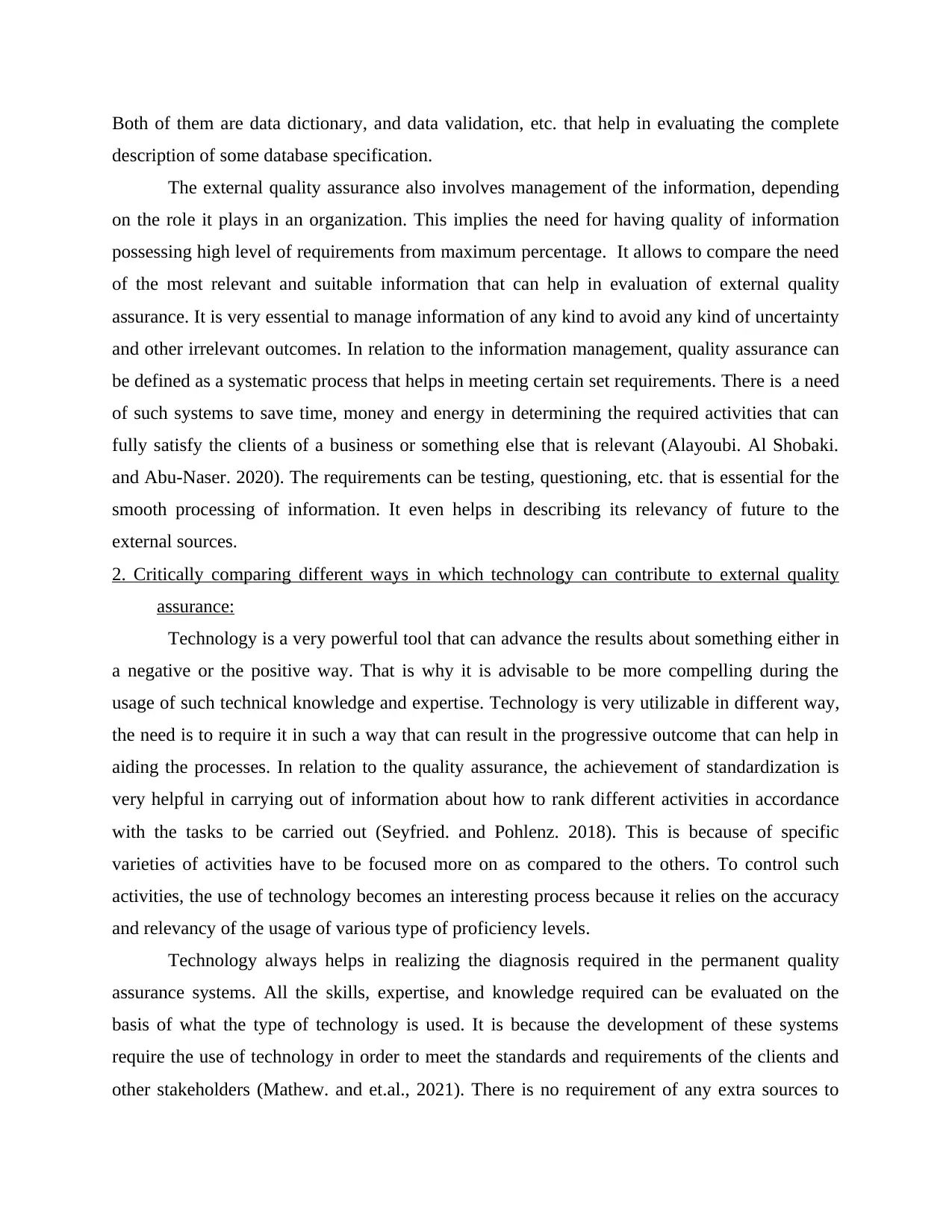
Both of them are data dictionary, and data validation, etc. that help in evaluating the complete
description of some database specification.
The external quality assurance also involves management of the information, depending
on the role it plays in an organization. This implies the need for having quality of information
possessing high level of requirements from maximum percentage. It allows to compare the need
of the most relevant and suitable information that can help in evaluation of external quality
assurance. It is very essential to manage information of any kind to avoid any kind of uncertainty
and other irrelevant outcomes. In relation to the information management, quality assurance can
be defined as a systematic process that helps in meeting certain set requirements. There is a need
of such systems to save time, money and energy in determining the required activities that can
fully satisfy the clients of a business or something else that is relevant (Alayoubi. Al Shobaki.
and Abu-Naser. 2020). The requirements can be testing, questioning, etc. that is essential for the
smooth processing of information. It even helps in describing its relevancy of future to the
external sources.
2. Critically comparing different ways in which technology can contribute to external quality
assurance:
Technology is a very powerful tool that can advance the results about something either in
a negative or the positive way. That is why it is advisable to be more compelling during the
usage of such technical knowledge and expertise. Technology is very utilizable in different way,
the need is to require it in such a way that can result in the progressive outcome that can help in
aiding the processes. In relation to the quality assurance, the achievement of standardization is
very helpful in carrying out of information about how to rank different activities in accordance
with the tasks to be carried out (Seyfried. and Pohlenz. 2018). This is because of specific
varieties of activities have to be focused more on as compared to the others. To control such
activities, the use of technology becomes an interesting process because it relies on the accuracy
and relevancy of the usage of various type of proficiency levels.
Technology always helps in realizing the diagnosis required in the permanent quality
assurance systems. All the skills, expertise, and knowledge required can be evaluated on the
basis of what the type of technology is used. It is because the development of these systems
require the use of technology in order to meet the standards and requirements of the clients and
other stakeholders (Mathew. and et.al., 2021). There is no requirement of any extra sources to
description of some database specification.
The external quality assurance also involves management of the information, depending
on the role it plays in an organization. This implies the need for having quality of information
possessing high level of requirements from maximum percentage. It allows to compare the need
of the most relevant and suitable information that can help in evaluation of external quality
assurance. It is very essential to manage information of any kind to avoid any kind of uncertainty
and other irrelevant outcomes. In relation to the information management, quality assurance can
be defined as a systematic process that helps in meeting certain set requirements. There is a need
of such systems to save time, money and energy in determining the required activities that can
fully satisfy the clients of a business or something else that is relevant (Alayoubi. Al Shobaki.
and Abu-Naser. 2020). The requirements can be testing, questioning, etc. that is essential for the
smooth processing of information. It even helps in describing its relevancy of future to the
external sources.
2. Critically comparing different ways in which technology can contribute to external quality
assurance:
Technology is a very powerful tool that can advance the results about something either in
a negative or the positive way. That is why it is advisable to be more compelling during the
usage of such technical knowledge and expertise. Technology is very utilizable in different way,
the need is to require it in such a way that can result in the progressive outcome that can help in
aiding the processes. In relation to the quality assurance, the achievement of standardization is
very helpful in carrying out of information about how to rank different activities in accordance
with the tasks to be carried out (Seyfried. and Pohlenz. 2018). This is because of specific
varieties of activities have to be focused more on as compared to the others. To control such
activities, the use of technology becomes an interesting process because it relies on the accuracy
and relevancy of the usage of various type of proficiency levels.
Technology always helps in realizing the diagnosis required in the permanent quality
assurance systems. All the skills, expertise, and knowledge required can be evaluated on the
basis of what the type of technology is used. It is because the development of these systems
require the use of technology in order to meet the standards and requirements of the clients and
other stakeholders (Mathew. and et.al., 2021). There is no requirement of any extra sources to
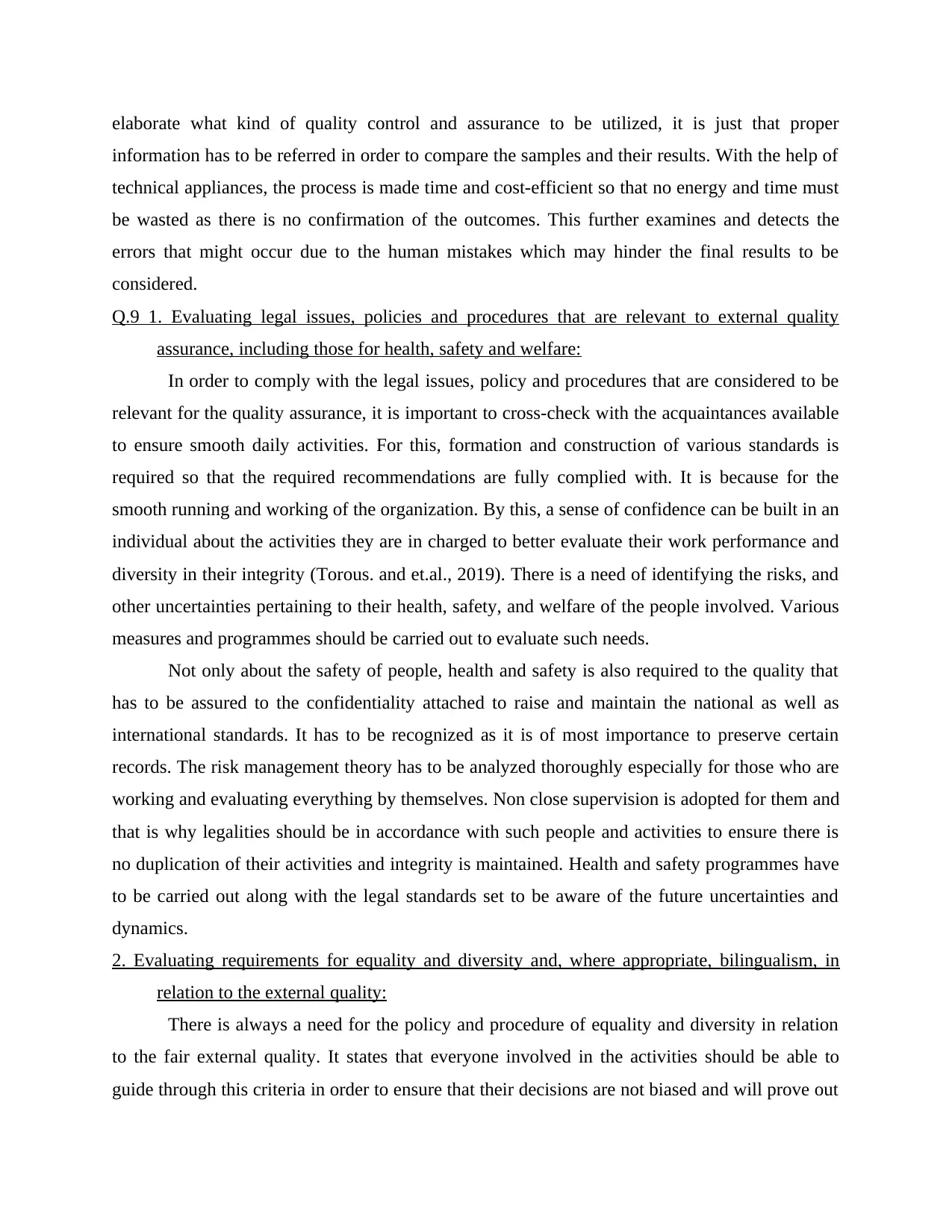
elaborate what kind of quality control and assurance to be utilized, it is just that proper
information has to be referred in order to compare the samples and their results. With the help of
technical appliances, the process is made time and cost-efficient so that no energy and time must
be wasted as there is no confirmation of the outcomes. This further examines and detects the
errors that might occur due to the human mistakes which may hinder the final results to be
considered.
Q.9 1. Evaluating legal issues, policies and procedures that are relevant to external quality
assurance, including those for health, safety and welfare:
In order to comply with the legal issues, policy and procedures that are considered to be
relevant for the quality assurance, it is important to cross-check with the acquaintances available
to ensure smooth daily activities. For this, formation and construction of various standards is
required so that the required recommendations are fully complied with. It is because for the
smooth running and working of the organization. By this, a sense of confidence can be built in an
individual about the activities they are in charged to better evaluate their work performance and
diversity in their integrity (Torous. and et.al., 2019). There is a need of identifying the risks, and
other uncertainties pertaining to their health, safety, and welfare of the people involved. Various
measures and programmes should be carried out to evaluate such needs.
Not only about the safety of people, health and safety is also required to the quality that
has to be assured to the confidentiality attached to raise and maintain the national as well as
international standards. It has to be recognized as it is of most importance to preserve certain
records. The risk management theory has to be analyzed thoroughly especially for those who are
working and evaluating everything by themselves. Non close supervision is adopted for them and
that is why legalities should be in accordance with such people and activities to ensure there is
no duplication of their activities and integrity is maintained. Health and safety programmes have
to be carried out along with the legal standards set to be aware of the future uncertainties and
dynamics.
2. Evaluating requirements for equality and diversity and, where appropriate, bilingualism, in
relation to the external quality:
There is always a need for the policy and procedure of equality and diversity in relation
to the fair external quality. It states that everyone involved in the activities should be able to
guide through this criteria in order to ensure that their decisions are not biased and will prove out
information has to be referred in order to compare the samples and their results. With the help of
technical appliances, the process is made time and cost-efficient so that no energy and time must
be wasted as there is no confirmation of the outcomes. This further examines and detects the
errors that might occur due to the human mistakes which may hinder the final results to be
considered.
Q.9 1. Evaluating legal issues, policies and procedures that are relevant to external quality
assurance, including those for health, safety and welfare:
In order to comply with the legal issues, policy and procedures that are considered to be
relevant for the quality assurance, it is important to cross-check with the acquaintances available
to ensure smooth daily activities. For this, formation and construction of various standards is
required so that the required recommendations are fully complied with. It is because for the
smooth running and working of the organization. By this, a sense of confidence can be built in an
individual about the activities they are in charged to better evaluate their work performance and
diversity in their integrity (Torous. and et.al., 2019). There is a need of identifying the risks, and
other uncertainties pertaining to their health, safety, and welfare of the people involved. Various
measures and programmes should be carried out to evaluate such needs.
Not only about the safety of people, health and safety is also required to the quality that
has to be assured to the confidentiality attached to raise and maintain the national as well as
international standards. It has to be recognized as it is of most importance to preserve certain
records. The risk management theory has to be analyzed thoroughly especially for those who are
working and evaluating everything by themselves. Non close supervision is adopted for them and
that is why legalities should be in accordance with such people and activities to ensure there is
no duplication of their activities and integrity is maintained. Health and safety programmes have
to be carried out along with the legal standards set to be aware of the future uncertainties and
dynamics.
2. Evaluating requirements for equality and diversity and, where appropriate, bilingualism, in
relation to the external quality:
There is always a need for the policy and procedure of equality and diversity in relation
to the fair external quality. It states that everyone involved in the activities should be able to
guide through this criteria in order to ensure that their decisions are not biased and will prove out
Secure Best Marks with AI Grader
Need help grading? Try our AI Grader for instant feedback on your assignments.
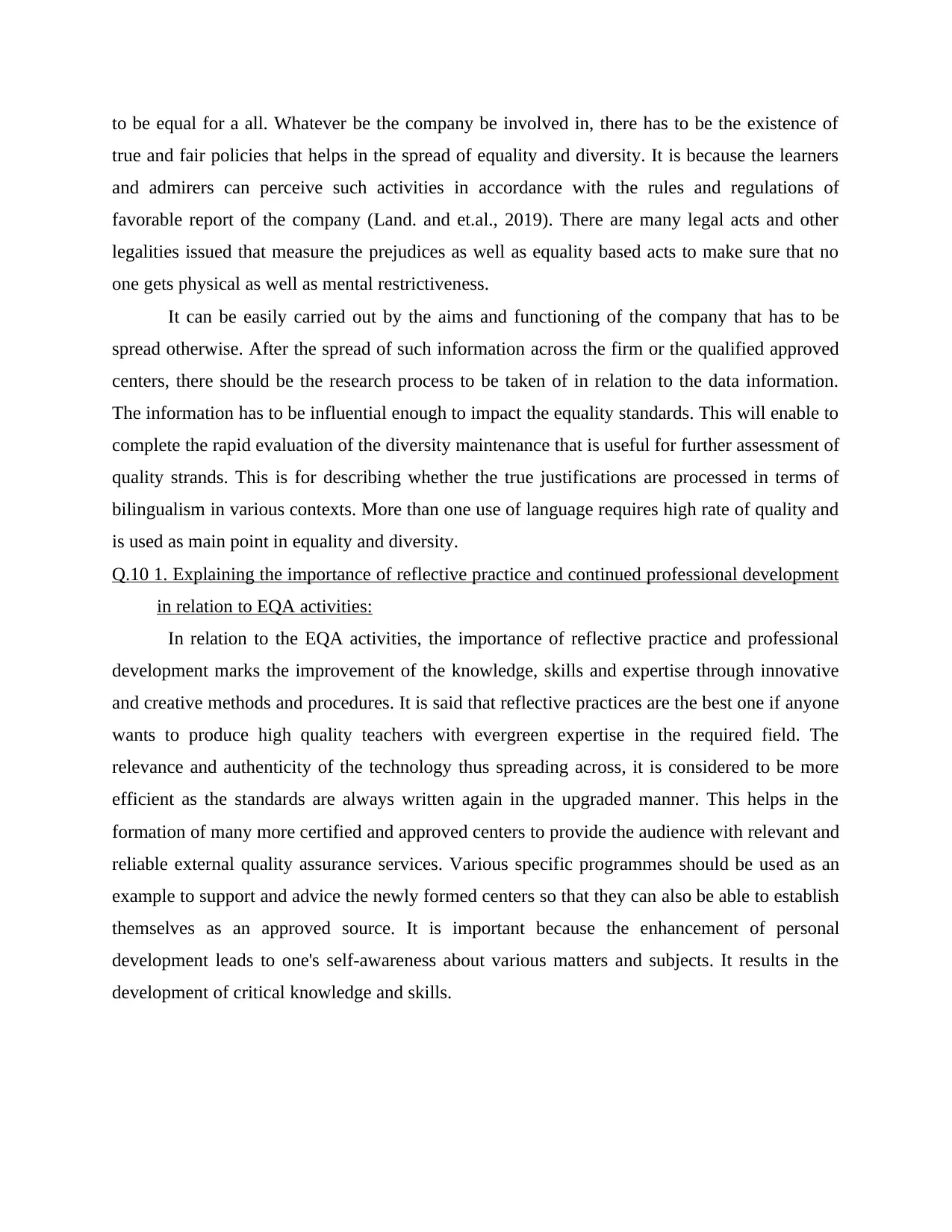
to be equal for a all. Whatever be the company be involved in, there has to be the existence of
true and fair policies that helps in the spread of equality and diversity. It is because the learners
and admirers can perceive such activities in accordance with the rules and regulations of
favorable report of the company (Land. and et.al., 2019). There are many legal acts and other
legalities issued that measure the prejudices as well as equality based acts to make sure that no
one gets physical as well as mental restrictiveness.
It can be easily carried out by the aims and functioning of the company that has to be
spread otherwise. After the spread of such information across the firm or the qualified approved
centers, there should be the research process to be taken of in relation to the data information.
The information has to be influential enough to impact the equality standards. This will enable to
complete the rapid evaluation of the diversity maintenance that is useful for further assessment of
quality strands. This is for describing whether the true justifications are processed in terms of
bilingualism in various contexts. More than one use of language requires high rate of quality and
is used as main point in equality and diversity.
Q.10 1. Explaining the importance of reflective practice and continued professional development
in relation to EQA activities:
In relation to the EQA activities, the importance of reflective practice and professional
development marks the improvement of the knowledge, skills and expertise through innovative
and creative methods and procedures. It is said that reflective practices are the best one if anyone
wants to produce high quality teachers with evergreen expertise in the required field. The
relevance and authenticity of the technology thus spreading across, it is considered to be more
efficient as the standards are always written again in the upgraded manner. This helps in the
formation of many more certified and approved centers to provide the audience with relevant and
reliable external quality assurance services. Various specific programmes should be used as an
example to support and advice the newly formed centers so that they can also be able to establish
themselves as an approved source. It is important because the enhancement of personal
development leads to one's self-awareness about various matters and subjects. It results in the
development of critical knowledge and skills.
true and fair policies that helps in the spread of equality and diversity. It is because the learners
and admirers can perceive such activities in accordance with the rules and regulations of
favorable report of the company (Land. and et.al., 2019). There are many legal acts and other
legalities issued that measure the prejudices as well as equality based acts to make sure that no
one gets physical as well as mental restrictiveness.
It can be easily carried out by the aims and functioning of the company that has to be
spread otherwise. After the spread of such information across the firm or the qualified approved
centers, there should be the research process to be taken of in relation to the data information.
The information has to be influential enough to impact the equality standards. This will enable to
complete the rapid evaluation of the diversity maintenance that is useful for further assessment of
quality strands. This is for describing whether the true justifications are processed in terms of
bilingualism in various contexts. More than one use of language requires high rate of quality and
is used as main point in equality and diversity.
Q.10 1. Explaining the importance of reflective practice and continued professional development
in relation to EQA activities:
In relation to the EQA activities, the importance of reflective practice and professional
development marks the improvement of the knowledge, skills and expertise through innovative
and creative methods and procedures. It is said that reflective practices are the best one if anyone
wants to produce high quality teachers with evergreen expertise in the required field. The
relevance and authenticity of the technology thus spreading across, it is considered to be more
efficient as the standards are always written again in the upgraded manner. This helps in the
formation of many more certified and approved centers to provide the audience with relevant and
reliable external quality assurance services. Various specific programmes should be used as an
example to support and advice the newly formed centers so that they can also be able to establish
themselves as an approved source. It is important because the enhancement of personal
development leads to one's self-awareness about various matters and subjects. It results in the
development of critical knowledge and skills.
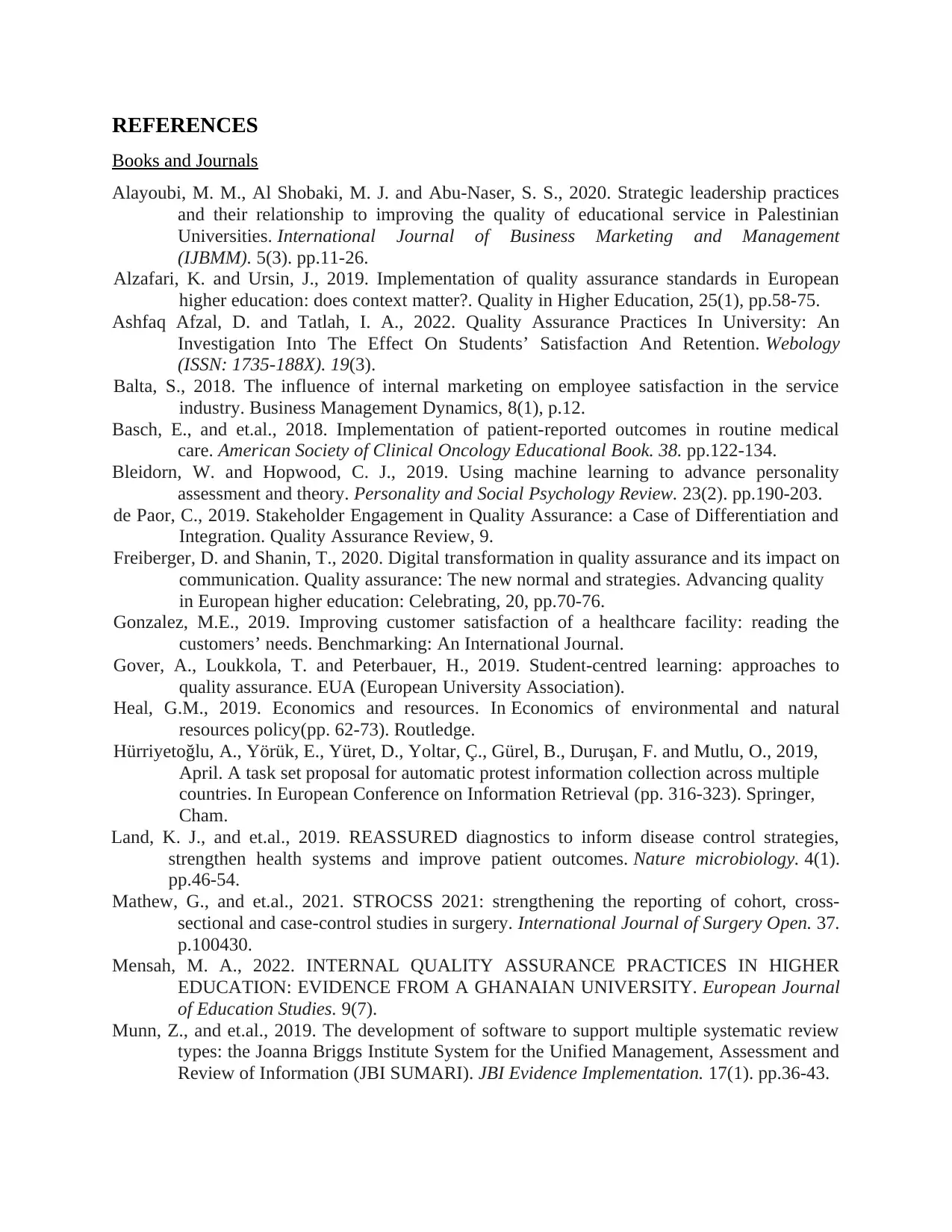
REFERENCES
Books and Journals
Alayoubi, M. M., Al Shobaki, M. J. and Abu-Naser, S. S., 2020. Strategic leadership practices
and their relationship to improving the quality of educational service in Palestinian
Universities. International Journal of Business Marketing and Management
(IJBMM). 5(3). pp.11-26.
Alzafari, K. and Ursin, J., 2019. Implementation of quality assurance standards in European
higher education: does context matter?. Quality in Higher Education, 25(1), pp.58-75.
Ashfaq Afzal, D. and Tatlah, I. A., 2022. Quality Assurance Practices In University: An
Investigation Into The Effect On Students’ Satisfaction And Retention. Webology
(ISSN: 1735-188X). 19(3).
Balta, S., 2018. The influence of internal marketing on employee satisfaction in the service
industry. Business Management Dynamics, 8(1), p.12.
Basch, E., and et.al., 2018. Implementation of patient-reported outcomes in routine medical
care. American Society of Clinical Oncology Educational Book. 38. pp.122-134.
Bleidorn, W. and Hopwood, C. J., 2019. Using machine learning to advance personality
assessment and theory. Personality and Social Psychology Review. 23(2). pp.190-203.
de Paor, C., 2019. Stakeholder Engagement in Quality Assurance: a Case of Differentiation and
Integration. Quality Assurance Review, 9.
Freiberger, D. and Shanin, T., 2020. Digital transformation in quality assurance and its impact on
communication. Quality assurance: The new normal and strategies. Advancing quality
in European higher education: Celebrating, 20, pp.70-76.
Gonzalez, M.E., 2019. Improving customer satisfaction of a healthcare facility: reading the
customers’ needs. Benchmarking: An International Journal.
Gover, A., Loukkola, T. and Peterbauer, H., 2019. Student-centred learning: approaches to
quality assurance. EUA (European University Association).
Heal, G.M., 2019. Economics and resources. In Economics of environmental and natural
resources policy(pp. 62-73). Routledge.
Hürriyetoğlu, A., Yörük, E., Yüret, D., Yoltar, Ç., Gürel, B., Duruşan, F. and Mutlu, O., 2019,
April. A task set proposal for automatic protest information collection across multiple
countries. In European Conference on Information Retrieval (pp. 316-323). Springer,
Cham.
Land, K. J., and et.al., 2019. REASSURED diagnostics to inform disease control strategies,
strengthen health systems and improve patient outcomes. Nature microbiology. 4(1).
pp.46-54.
Mathew, G., and et.al., 2021. STROCSS 2021: strengthening the reporting of cohort, cross-
sectional and case-control studies in surgery. International Journal of Surgery Open. 37.
p.100430.
Mensah, M. A., 2022. INTERNAL QUALITY ASSURANCE PRACTICES IN HIGHER
EDUCATION: EVIDENCE FROM A GHANAIAN UNIVERSITY. European Journal
of Education Studies. 9(7).
Munn, Z., and et.al., 2019. The development of software to support multiple systematic review
types: the Joanna Briggs Institute System for the Unified Management, Assessment and
Review of Information (JBI SUMARI). JBI Evidence Implementation. 17(1). pp.36-43.
Books and Journals
Alayoubi, M. M., Al Shobaki, M. J. and Abu-Naser, S. S., 2020. Strategic leadership practices
and their relationship to improving the quality of educational service in Palestinian
Universities. International Journal of Business Marketing and Management
(IJBMM). 5(3). pp.11-26.
Alzafari, K. and Ursin, J., 2019. Implementation of quality assurance standards in European
higher education: does context matter?. Quality in Higher Education, 25(1), pp.58-75.
Ashfaq Afzal, D. and Tatlah, I. A., 2022. Quality Assurance Practices In University: An
Investigation Into The Effect On Students’ Satisfaction And Retention. Webology
(ISSN: 1735-188X). 19(3).
Balta, S., 2018. The influence of internal marketing on employee satisfaction in the service
industry. Business Management Dynamics, 8(1), p.12.
Basch, E., and et.al., 2018. Implementation of patient-reported outcomes in routine medical
care. American Society of Clinical Oncology Educational Book. 38. pp.122-134.
Bleidorn, W. and Hopwood, C. J., 2019. Using machine learning to advance personality
assessment and theory. Personality and Social Psychology Review. 23(2). pp.190-203.
de Paor, C., 2019. Stakeholder Engagement in Quality Assurance: a Case of Differentiation and
Integration. Quality Assurance Review, 9.
Freiberger, D. and Shanin, T., 2020. Digital transformation in quality assurance and its impact on
communication. Quality assurance: The new normal and strategies. Advancing quality
in European higher education: Celebrating, 20, pp.70-76.
Gonzalez, M.E., 2019. Improving customer satisfaction of a healthcare facility: reading the
customers’ needs. Benchmarking: An International Journal.
Gover, A., Loukkola, T. and Peterbauer, H., 2019. Student-centred learning: approaches to
quality assurance. EUA (European University Association).
Heal, G.M., 2019. Economics and resources. In Economics of environmental and natural
resources policy(pp. 62-73). Routledge.
Hürriyetoğlu, A., Yörük, E., Yüret, D., Yoltar, Ç., Gürel, B., Duruşan, F. and Mutlu, O., 2019,
April. A task set proposal for automatic protest information collection across multiple
countries. In European Conference on Information Retrieval (pp. 316-323). Springer,
Cham.
Land, K. J., and et.al., 2019. REASSURED diagnostics to inform disease control strategies,
strengthen health systems and improve patient outcomes. Nature microbiology. 4(1).
pp.46-54.
Mathew, G., and et.al., 2021. STROCSS 2021: strengthening the reporting of cohort, cross-
sectional and case-control studies in surgery. International Journal of Surgery Open. 37.
p.100430.
Mensah, M. A., 2022. INTERNAL QUALITY ASSURANCE PRACTICES IN HIGHER
EDUCATION: EVIDENCE FROM A GHANAIAN UNIVERSITY. European Journal
of Education Studies. 9(7).
Munn, Z., and et.al., 2019. The development of software to support multiple systematic review
types: the Joanna Briggs Institute System for the Unified Management, Assessment and
Review of Information (JBI SUMARI). JBI Evidence Implementation. 17(1). pp.36-43.
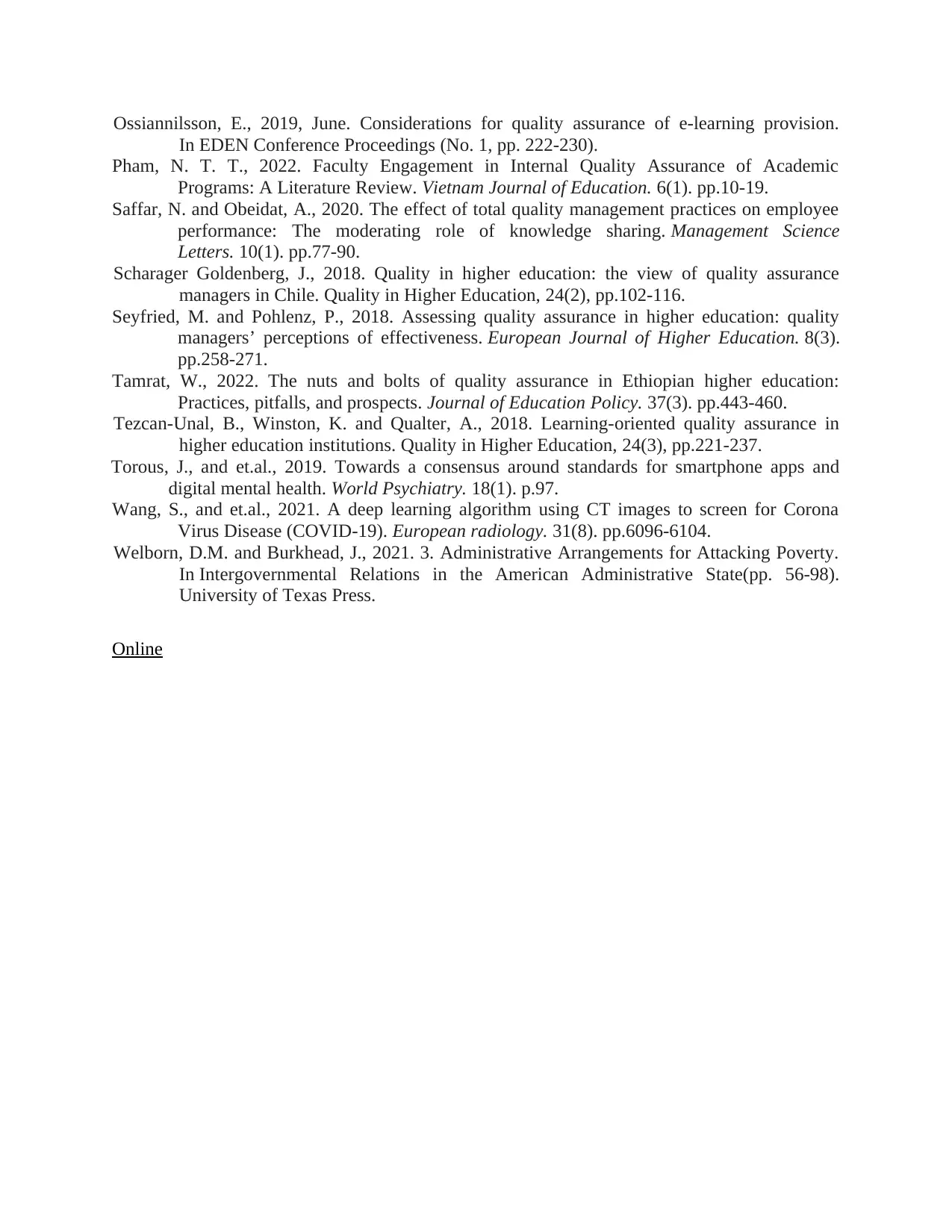
Ossiannilsson, E., 2019, June. Considerations for quality assurance of e-learning provision.
In EDEN Conference Proceedings (No. 1, pp. 222-230).
Pham, N. T. T., 2022. Faculty Engagement in Internal Quality Assurance of Academic
Programs: A Literature Review. Vietnam Journal of Education. 6(1). pp.10-19.
Saffar, N. and Obeidat, A., 2020. The effect of total quality management practices on employee
performance: The moderating role of knowledge sharing. Management Science
Letters. 10(1). pp.77-90.
Scharager Goldenberg, J., 2018. Quality in higher education: the view of quality assurance
managers in Chile. Quality in Higher Education, 24(2), pp.102-116.
Seyfried, M. and Pohlenz, P., 2018. Assessing quality assurance in higher education: quality
managers’ perceptions of effectiveness. European Journal of Higher Education. 8(3).
pp.258-271.
Tamrat, W., 2022. The nuts and bolts of quality assurance in Ethiopian higher education:
Practices, pitfalls, and prospects. Journal of Education Policy. 37(3). pp.443-460.
Tezcan-Unal, B., Winston, K. and Qualter, A., 2018. Learning-oriented quality assurance in
higher education institutions. Quality in Higher Education, 24(3), pp.221-237.
Torous, J., and et.al., 2019. Towards a consensus around standards for smartphone apps and
digital mental health. World Psychiatry. 18(1). p.97.
Wang, S., and et.al., 2021. A deep learning algorithm using CT images to screen for Corona
Virus Disease (COVID-19). European radiology. 31(8). pp.6096-6104.
Welborn, D.M. and Burkhead, J., 2021. 3. Administrative Arrangements for Attacking Poverty.
In Intergovernmental Relations in the American Administrative State(pp. 56-98).
University of Texas Press.
Online
In EDEN Conference Proceedings (No. 1, pp. 222-230).
Pham, N. T. T., 2022. Faculty Engagement in Internal Quality Assurance of Academic
Programs: A Literature Review. Vietnam Journal of Education. 6(1). pp.10-19.
Saffar, N. and Obeidat, A., 2020. The effect of total quality management practices on employee
performance: The moderating role of knowledge sharing. Management Science
Letters. 10(1). pp.77-90.
Scharager Goldenberg, J., 2018. Quality in higher education: the view of quality assurance
managers in Chile. Quality in Higher Education, 24(2), pp.102-116.
Seyfried, M. and Pohlenz, P., 2018. Assessing quality assurance in higher education: quality
managers’ perceptions of effectiveness. European Journal of Higher Education. 8(3).
pp.258-271.
Tamrat, W., 2022. The nuts and bolts of quality assurance in Ethiopian higher education:
Practices, pitfalls, and prospects. Journal of Education Policy. 37(3). pp.443-460.
Tezcan-Unal, B., Winston, K. and Qualter, A., 2018. Learning-oriented quality assurance in
higher education institutions. Quality in Higher Education, 24(3), pp.221-237.
Torous, J., and et.al., 2019. Towards a consensus around standards for smartphone apps and
digital mental health. World Psychiatry. 18(1). p.97.
Wang, S., and et.al., 2021. A deep learning algorithm using CT images to screen for Corona
Virus Disease (COVID-19). European radiology. 31(8). pp.6096-6104.
Welborn, D.M. and Burkhead, J., 2021. 3. Administrative Arrangements for Attacking Poverty.
In Intergovernmental Relations in the American Administrative State(pp. 56-98).
University of Texas Press.
Online
1 out of 19
Related Documents
Your All-in-One AI-Powered Toolkit for Academic Success.
+13062052269
info@desklib.com
Available 24*7 on WhatsApp / Email
![[object Object]](/_next/static/media/star-bottom.7253800d.svg)
Unlock your academic potential
© 2024 | Zucol Services PVT LTD | All rights reserved.





